Metals: From Mountains to Plains
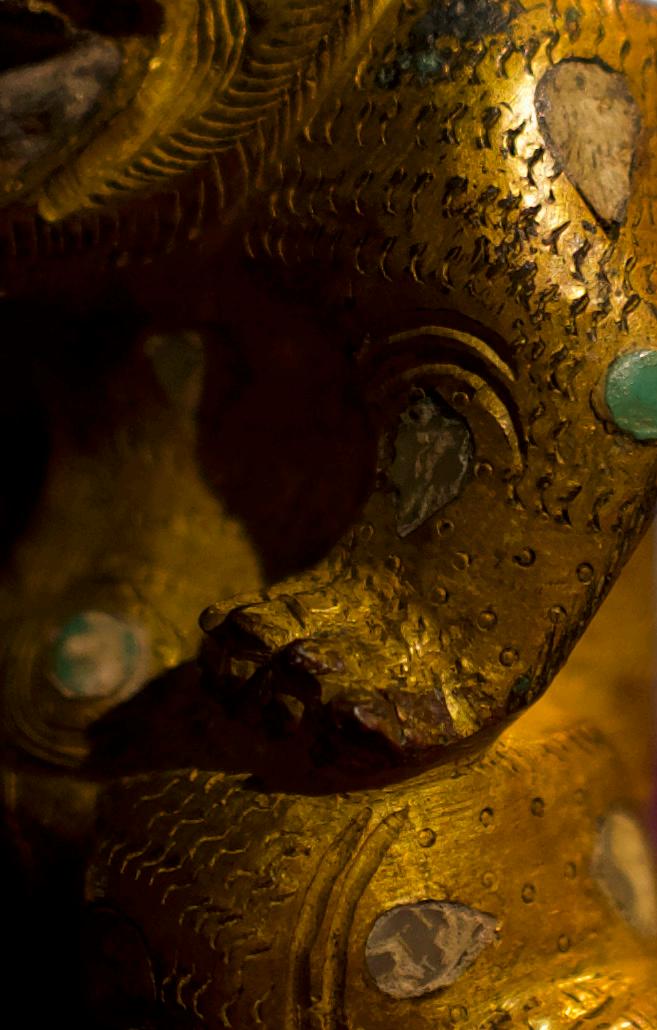
28th AUG - 19th SEP 2025


28th AUG - 19th SEP 2025
Founded in 1988 by the esteemed connoisseur known affectionately as “Mama Lin,” Lam’s Gallery has built a renowned reputation in the international Chinese art market. Over the course of more than three decades, the gallery has earned the trust of collectors, scholars, and institutions worldwide through its unwavering commitment to authenticity, scholarship, and curatorial excellence.
Since the 1990s, the gallery has been led by the second-generation owner, Ms. Midco Lam (林雲翔), whose expertise spans over 30 years in the field. With an extensive understanding of Chinese cultural heritage dating back more than 5,000 years, she has handled an extraordinary array of materials, including ceramics, bronzes, archaic jades, calligraphy, and classical painting. Ms. Lam’s work is widely respected by leading museums, renowned auction houses, esteemed dealers, and discerning private collectors.
Located in M Place, Wong Chuk Hang, Hong Kong, the gallery regularly stages exhibitions that reflect its commitment to quality and historical depth. In addition to her role at Lam’s Gallery, Ms. Lam is also the founder of Songyin Hall (松隱閣), a private collection brand. Highlights from the Songyin Hall collection have been exhibited at the University Museum and Art Gallery (UMAG) of the University of Hong Kong, where Ms. Midco Lam has also generously contributed works from her collection in support of public scholarship and education.

22/f, M Place
54 Wong Chuk Hang Rd, Southern District, Hong Kong
Email: midcolam.art@gmail.com
Instagram: Lamsgallery_Online
WeChat: Midcolam1177
Website: http://www.lams-gallery.com
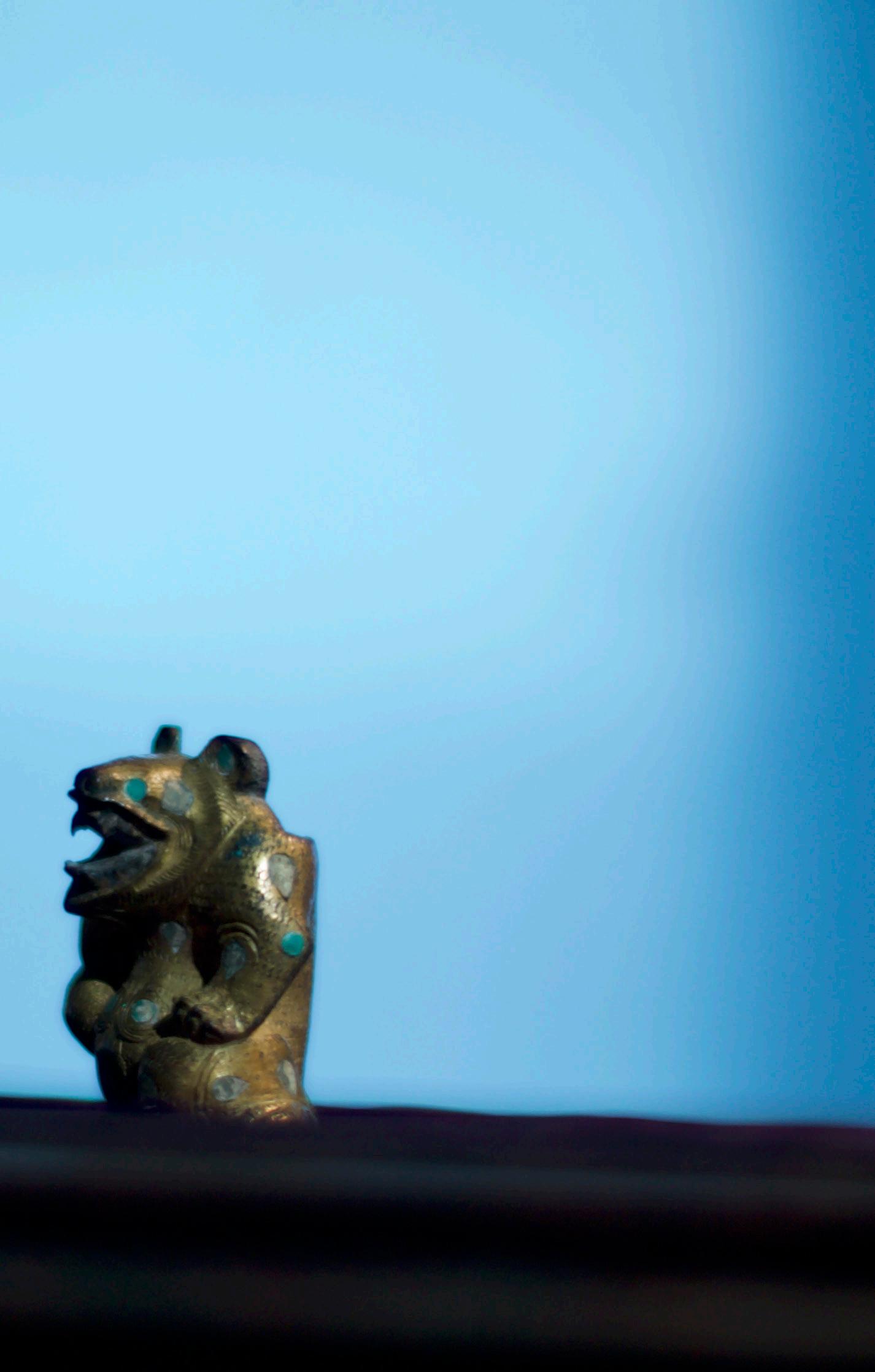
「松心閣」Lam’s Gallery 成立於1988年,由備受行業 尊敬的鑑賞家“林媽媽”創辦,已在國際中國藝術市場中 建立了卓越的聲譽。在超過三十年的發展過程中,該畫 廊以對真品的堅持、學術研究的深度及策展的卓越表 現,贏得了收藏家、學者和機構的持久信任。
林雲翔女士(Midco Lam)於1990年代踏足古代藝術行 業,至今已有超過30年的專業經歷,涉及門類包括陶瓷、 青銅器、古代玉器、書法及古代繪畫。畫廊的專業成就已 得到世界著名博物館、領先拍賣行、尊貴經銷商以私人 收藏家的認可與尊重。
「松心閣 by Midco」之外,林雲翔女士還創辦了其私人 收藏品牌——松隱閣(Songyin Hall)。松隱閣部分藏品 亦經林女士捐贈,入藏香港大學的藝術博物館(UMAG) ,以支持公共學術及教育事業。
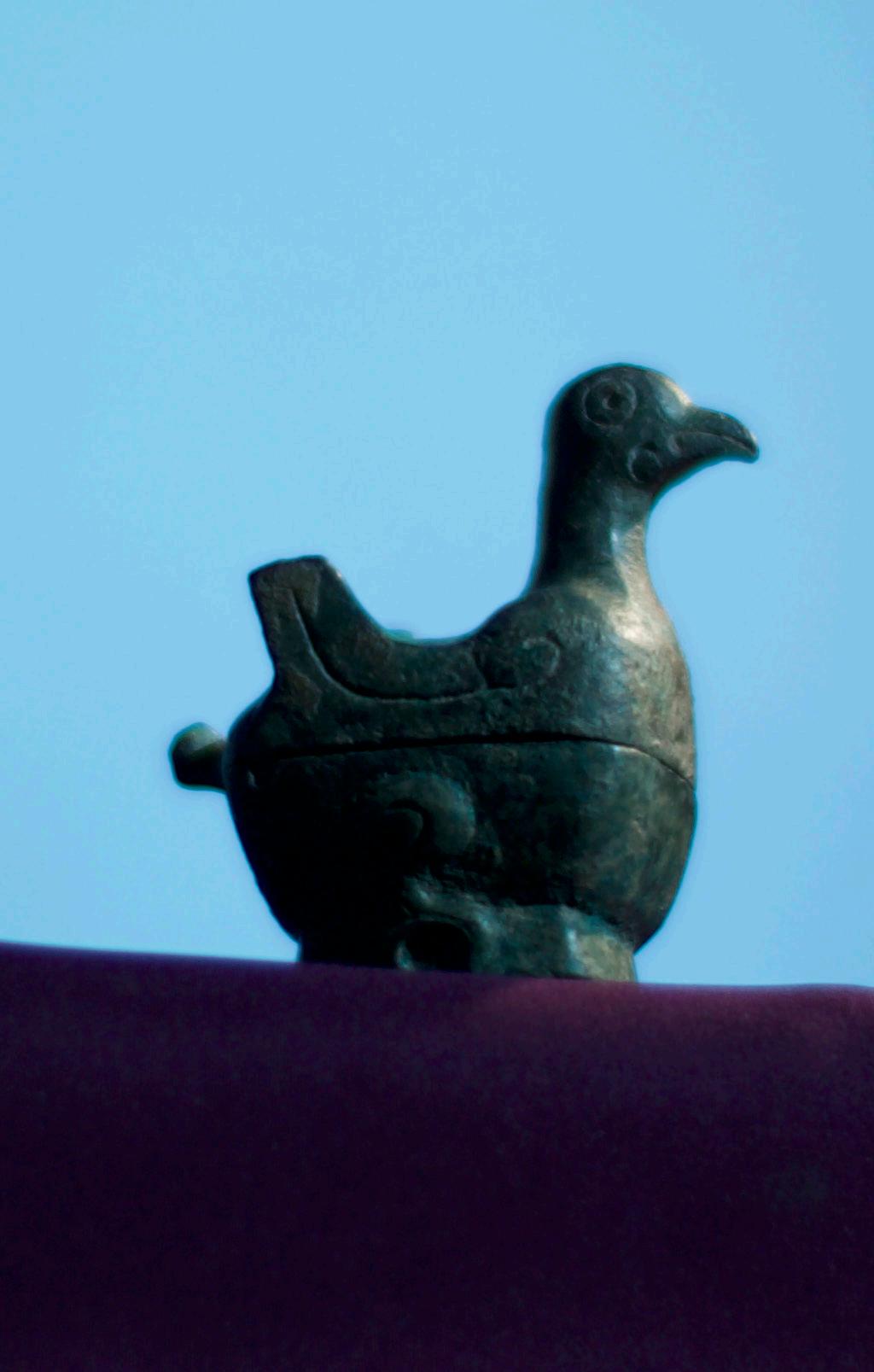


This significant Western Zhou bronze bird-shaped covered box comes from the renowned Dutch collector of Chinese bronzes, Williem van Heusden.
In 1952, he wrote: "This little vessel appears to be unique, and I am not sure how it should be classified (possibly as a kuang?)."
Williem van Heusden, a famous Dutch collector of Chinese bronzes, compiled and cataloged his extensive collection of rare ancient Chinese bronzes and published it in Tokyo in 1952 as a large, deluxe collotype edition titled Ancient Chinese Bronzes. The book, known in Chinese as Baodingzhai Catalogue of Bronzes from the Three Dynasties, was limited to just 1,000 copies, with each copy containing Van Heusden's handwritten signature and seal on the front page.
This work remains an essential reference for the study of Chinese bronze.
這件西周青銅鳥形蓋盒來自荷蘭著名中國青銅器收藏家萬孝臣(Williem van Heusden),他於 1952 年寫道:這件小器物似乎是獨一無 二的,我不確定該如何歸類(可能是屬於「觥」?)。
荷蘭萬孝臣(Willem Van Heusden)為世界著名中國青銅器收藏 家,1952年他將自己所藏大量中國古代稀見青銅器匯編整理後在東 京出版成書:《寶鼎齋三代銅器圖錄》大型精裝珂羅版畫冊,此書僅發 行1000冊,扉頁留有萬孝臣氏親筆簽名及蓋章,是研究中國青銅器之 重要著作。
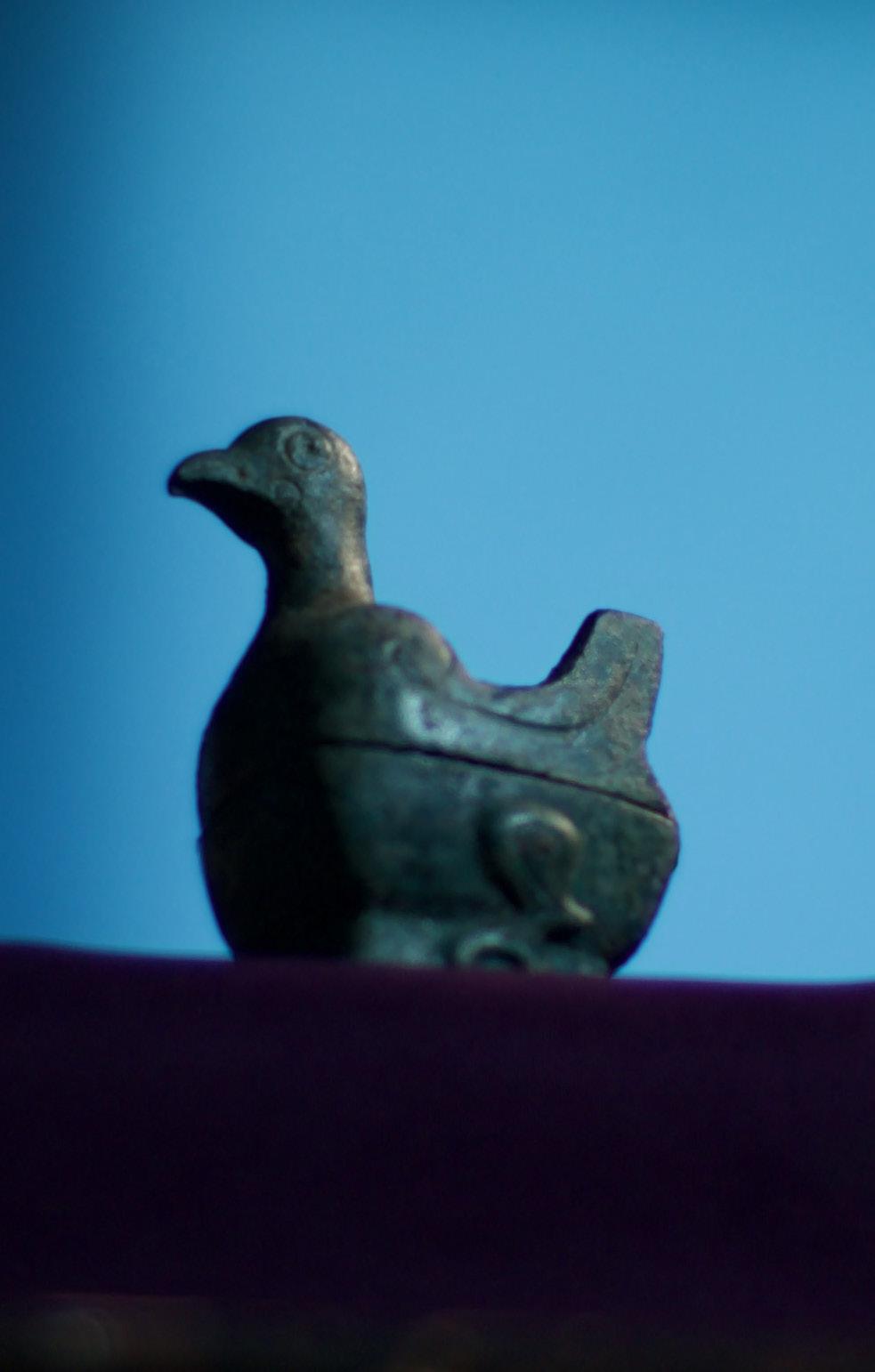
BOX IN THE SHAPE OF A DOVE
Western Zhou Dynasty
Provenance
Collection of Williem van Heusden, Before 1952 Collection of Georges deBatz.
Christie’s New York, 30th November 1983, lot 278.
Leshantang, Taiwan
Literature
Willem Van Heusden, Ancient Chinese Bronzes of the Shang and Chou Dynasties. An Illustrated Catalogue of the Van Heusden Collection with a historical Introduction by Willem van Heusden, Tokyo, 1952, p. 116, pl. XXIII.
青銅鳥形蓋盒
西周
來源:
Williem van Heusden 收藏,1952年以前
Georges deBatz 收藏
紐約佳士得1983年11月30日,編號278
樂山堂,蔡一鳴收藏
出版:
萬孝臣,《寶鼎齋三代銅器圖錄》,東京,1952年,頁116,圖版 XXIII
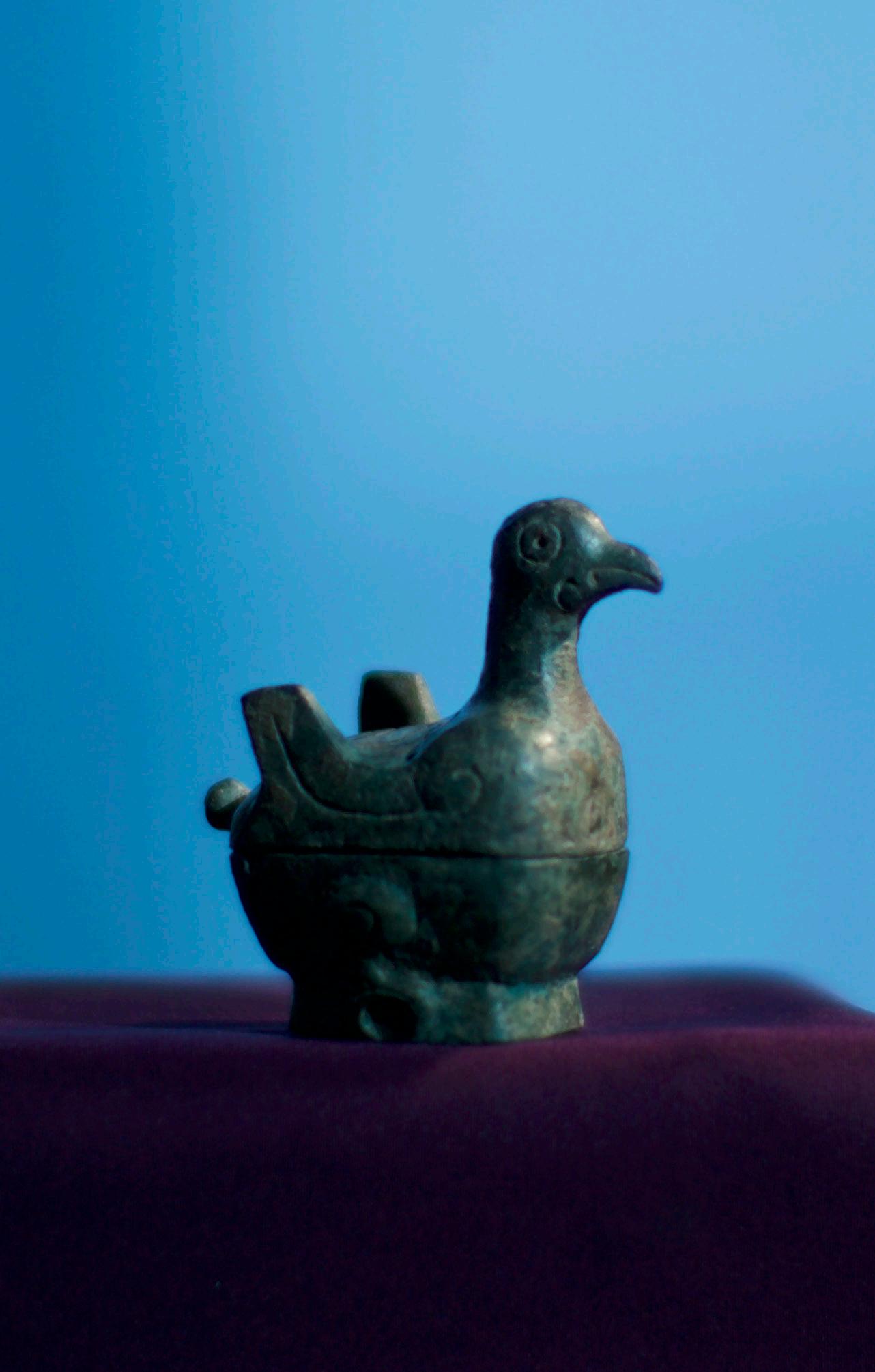
Eastern Zhou Dynasty, Warring States Period
Provenance
Fengwentang Collection, Hong Kong
Originally thought to be ornamental fittings, the precise function of the present key remained a mystery until the excavation of a Han dynasty tomb in 1983, where a similar example was discovered together with matching turning pegs (see Jenny So, ‘Different Turns, Different Strings: Court and Chamber Music in Ancient China’, Orientations, May 2000, p. 31). According to So, because the pegs were small and packed close together on a zither, a tuning key was needed to access them for tuning.
青銅子母猴軫鑰 東周戰國
來源: 奉文堂,香港
這種調音用的軫鑰最初被認為是裝飾性配件,直到1983年在一次漢 代墓葬的挖掘中,發現了一個相似的例子,並與匹配的調音桿一同出 土,由於這些桿子小且緊密地排列在古琴上,因此需要軫鑰來調音。
傳統上,這些軫鑰的頂部通常會雕刻動物或神話生物。舉例來說,一 件與此密切相關的範例的頂部裝飾有一隻公羊,出土於山西省長治 市,現藏於太原的山西博物院;另一件刻有虎和蛇交戰的範例現藏於 華盛頓D.C.的弗利爾美術館(收藏編號F1916.454);第三件裝飾熊, 曾是尤金·維克托·索伉儷收藏,現藏於紐約大都會藝術博物館(收藏 編號2002.201.150)
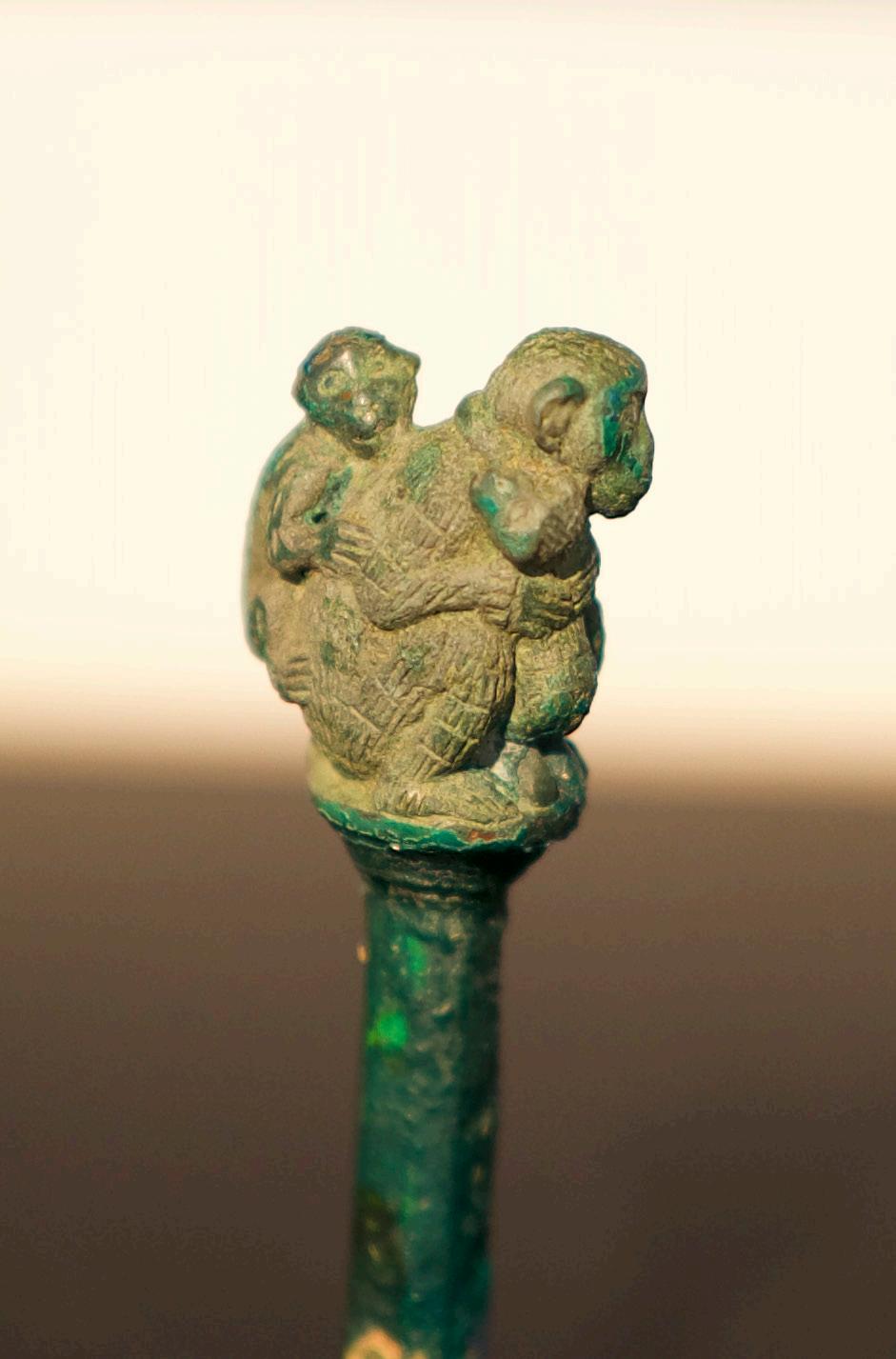

The bear has been an important totem in China since ancient times. In Chinese mythology, the Yellow Emperor is linked with the bear, having tamed it along with other beasts. After Gun failed to control the Yellow River’s floods and was killed, his body transformed into a yellow bear. From it, a golden bear—or sometimes a golden dragon—emerged, and the Yellow Emperor sent it to complete Gun’s task. This bear became Da Yu, who tamed the floods and founded the Xia Dynasty. The bear has been associated with strength, shamanism, and immortality. Additionally, the word for “bear” (xióng) is a homophone for “virility” in both modern and ancient Chinese, reinforcing its symbolic meaning.
The bear appears in Chinese art as early as the Shang Dynasty (c. 1600–c. 1050 BC). Jade bears were excavated from Lady Fu Hao’s tomb in Anyang in 1976, and the Harvard Art Museums hold two more. A rare marble sculpture from Anyang, depicting a human figure with a bear’s head, was also found. The Sumitomo Collection holds a famous Shang bronze ritual vessel in the form of a beast embracing a human. During the Han Dynasty, many bronze and ceramic vessels featured bear-shaped legs, symbolizing strength and formality.
熊自古以來即為中國重要的圖騰之一。在開國神話中,黃帝與熊有著 深厚的聯繫。傳說黃帝馴服了熊等猛獸,而熊也因此成為黃帝的象徵。
後來,鯀因盜取土壤未能治理黃河而被處死,其屍化為黃熊,並經由金 熊或金龍轉世成大禹,成功治水,成為夏朝的始祖。熊自上古以來與傳 說中的聖君及國家開創神話緊密相關,並且被視為軍事武勇、薩滿信 仰和長生不死的象徵。此外,熊與「雄」在古今漢語中同音,進一步加強 了其象徵意涵。
熊的形象在中國藝術中可追溯至商代(約公元前1600–前1050年) 。1976年,安陽婦好墓出土三件玉熊;哈佛大學藝術博物館也藏有兩 件玉熊。另一件罕見的大理石雕像,顯示跪坐的人身熊首,於1928年 出土於安陽西北岡 M1001 號大墓。商代最著名的熊形作品之一為住 友藏的青銅禦尊,呈巨獸吞噬人形。至漢代,青銅和陶器常以熊形作 器足,三足設計表現熊蹲踞,象徵力量與莊嚴。
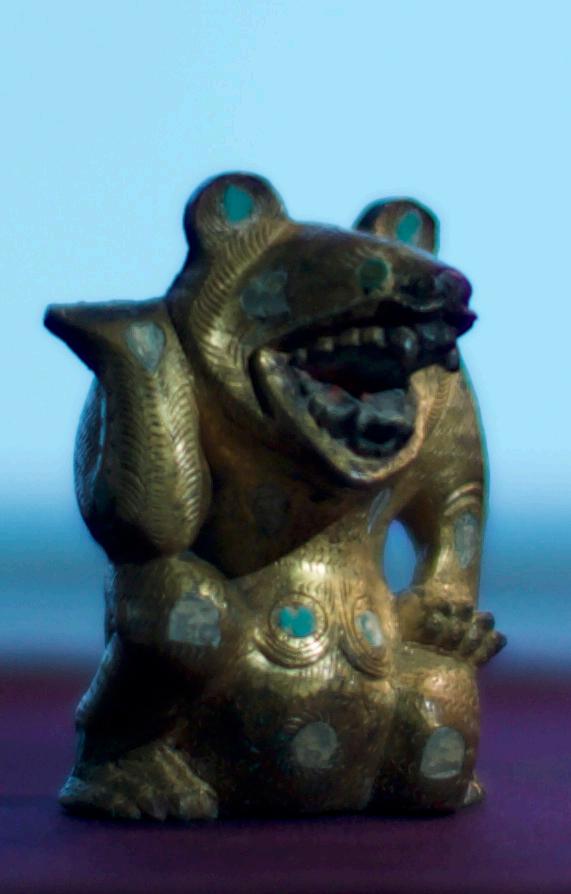
The heavy weight is cast in the shape of a seated bear with right forepaw raised and left resting on its thigh, and the mouth open. The fur is suggested by small linear markings, areas of tiny circles on the sides of the legs, and a textured stripe down the backbone. The eyes, ears and body are embellished with turquoise and hetian jade, and there is some red pigment in the mouth.
3 1/8 in. (8 cm.) high, box
Eskenazi, London, 2001. Reach Family Collection.
銅鎏金錯嵌和田玉綠松石熊鎮
漢代(公元前206年-公元220年)
此件熊鎮鑄造厚重,其表為端坐的熊形,右前爪高舉,左前爪則置於 足上,口部大張呈嘶吼狀,氣勢撼人。
熊身以細密線刻表現毛紋,腿部兩側飾以細小圓點紋,脊椎位置則飾 有一條具紋理的縱向條帶。雙眼、耳部及軀幹均嵌飾綠松石及和田玉 石,和田玉鑲嵌較為少見,熊口內尚殘留紅色硃砂痕跡。
高8公分(3 1/8英吋),附盒
來源
倫敦 埃斯肯納齊,2001年
Reach 家族舊藏
參考: 奈良博物館坂本五郎寄贈熊鎮


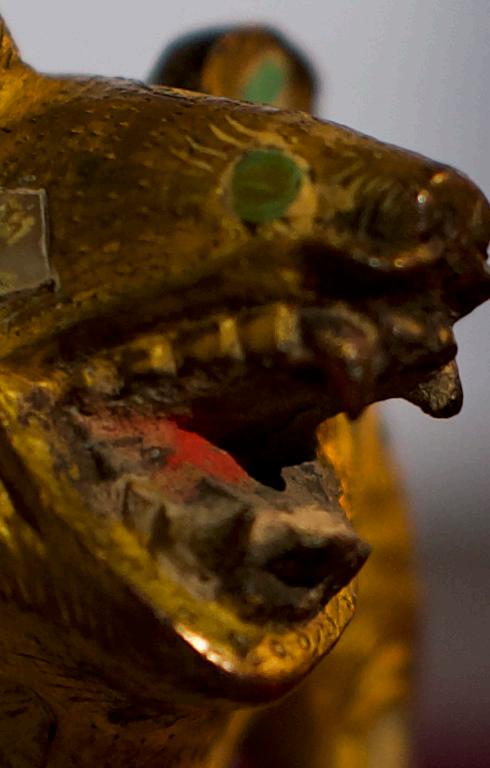


Camels are referred to by various names, including “tuo tuo,” “luo zhua,” and “tuo ta.” The “Shan Hai Jing” mentions, “Its beasts are mostly camels,” indicating their abundance in northern regions. In “Shi Ji,” it states, “In the Yan state, camels and good horses must be kept outside the stables,” highlighting camels’ importance alongside horses as transport. The “Hou Han Shu” records large-scale camel livestock, showing their military and agricultural significance. During the Han Dynasty, camels were primarily used in the northwestern frontier, such as by the Xiongnu and in the Western Regions. Central China had limited recognition of camels, and Sima Qian in “Shi Ji” regarded them as “exotic animals.”
According to the “Yi Zhou Shu,” during the Shang Dynasty, various northern tribes presented camels and other items as tribute to the central plains, showing that camels entered the region as early as the pre-Qin period, highlighting their role in trade between the north and central China.
After Zhang Qian’s mission to the Western Regions during the Han Dynasty, camels were gradually introduced to Han China. As an exotic “strange beast,” they were unfamiliar and not widely known, and there was a lack of exquisite artistic representations of them. In contrast to the large number of camel-related artifacts that appeared during the Tang Dynasty, Han Dynasty camel artifacts are extremely rare.
駱駝在文獻中有多種稱呼,如“橐駝”、“駱駞”、“駝”等等。《山海經·北 山經》記載:“其獸多橐駝”,表示駱駝在北方地區的豐富。《史記·蘇秦
列傳》中提到:“燕代橐駝、良馬必實外廏”,駱駝與馬匹並列為重要交 通工具。《後漢書·梁慬傳》則提到大量駱駝的畜產,顯示其在軍事和畜 牧中的作用。
漢代駱駝主要集中在西北邊疆,匈奴和西域地區使用較多。中原對駱 駝的認識有限,司馬遷在《史記》中將駱駝視為“奇畜”。
根據《逸周書·王會解》,商代伊尹記載北方各族進貢駱駝、白玉等物, 表明駱駝早在先秦時期已進入中原地區,顯示其在北方與中原的貿易 中地位重要。
漢代張騫通西域後,駱駝被逐步引進漢地,其作為外來“奇畜”不為人 知與熟悉,也缺少相應精湛造型的藝術品,與唐代出現的大量駱駝文 物相比,漢代駱駝文物寥寥無幾。
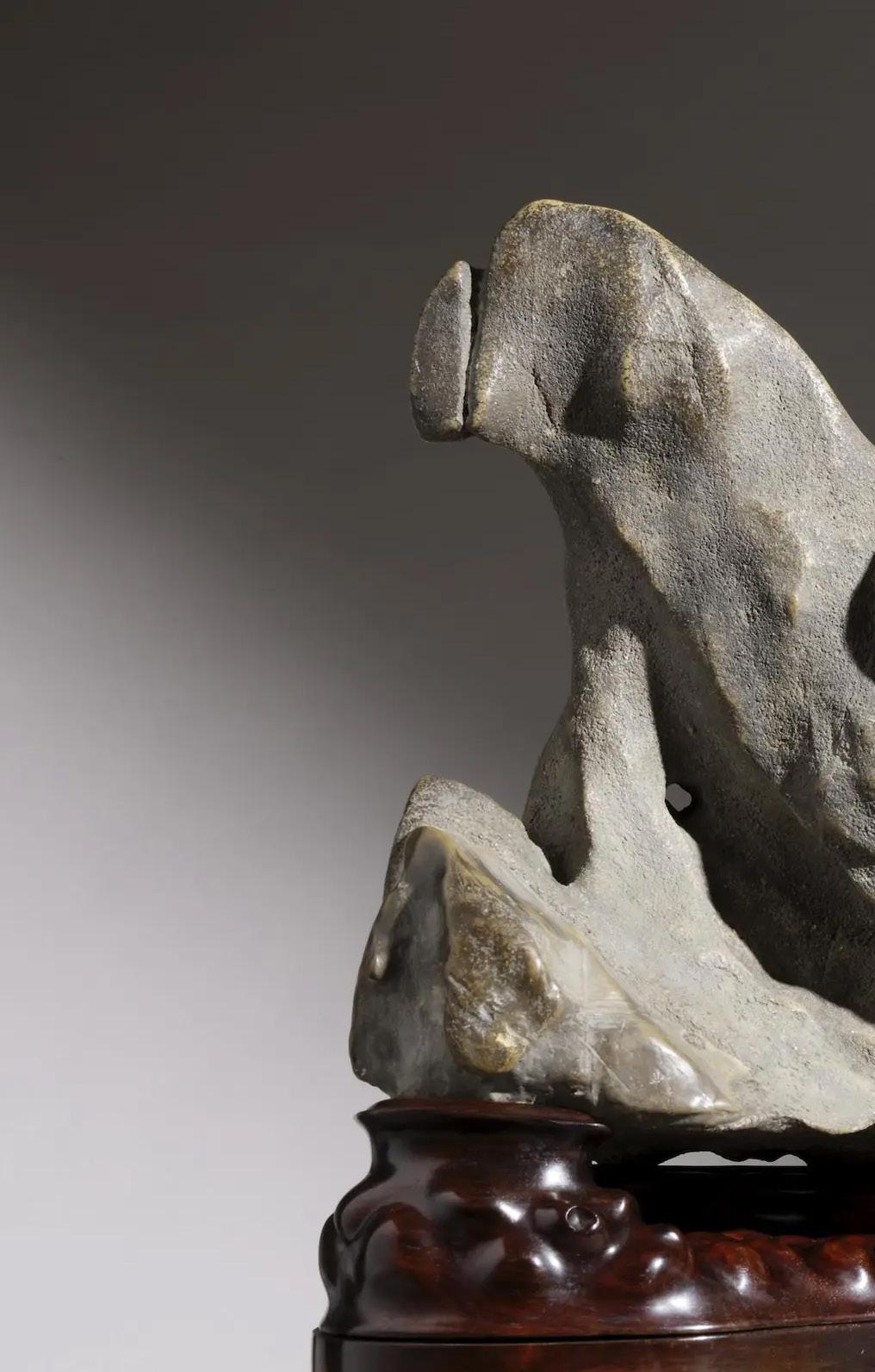
A TAIHU SCHOLAR’S ROCK
太湖石
Provenance:
Collection of Wu Hufan
The Wu family, and thence by descent
Maria Kiang Chinese Art Ltd., Hong Kong, October 2011
The Water, Pine And Stone Retreat Collection
Published and Illustrated:
Maria Kiang Chinese Art, Objects for the Scholar’s Desk, Hong Kong, 2010, p.90, no.32
來源:
吳湖帆舊藏
吳氏家族舊藏,後於家族内傳承
香港古董商Maria Kiang,2011年10月
水松石山房
出版及著錄:
Maria Kiang Chinese Art,《Objects for the Scholar’s Desk》,香
港,2010年,頁90,編號32
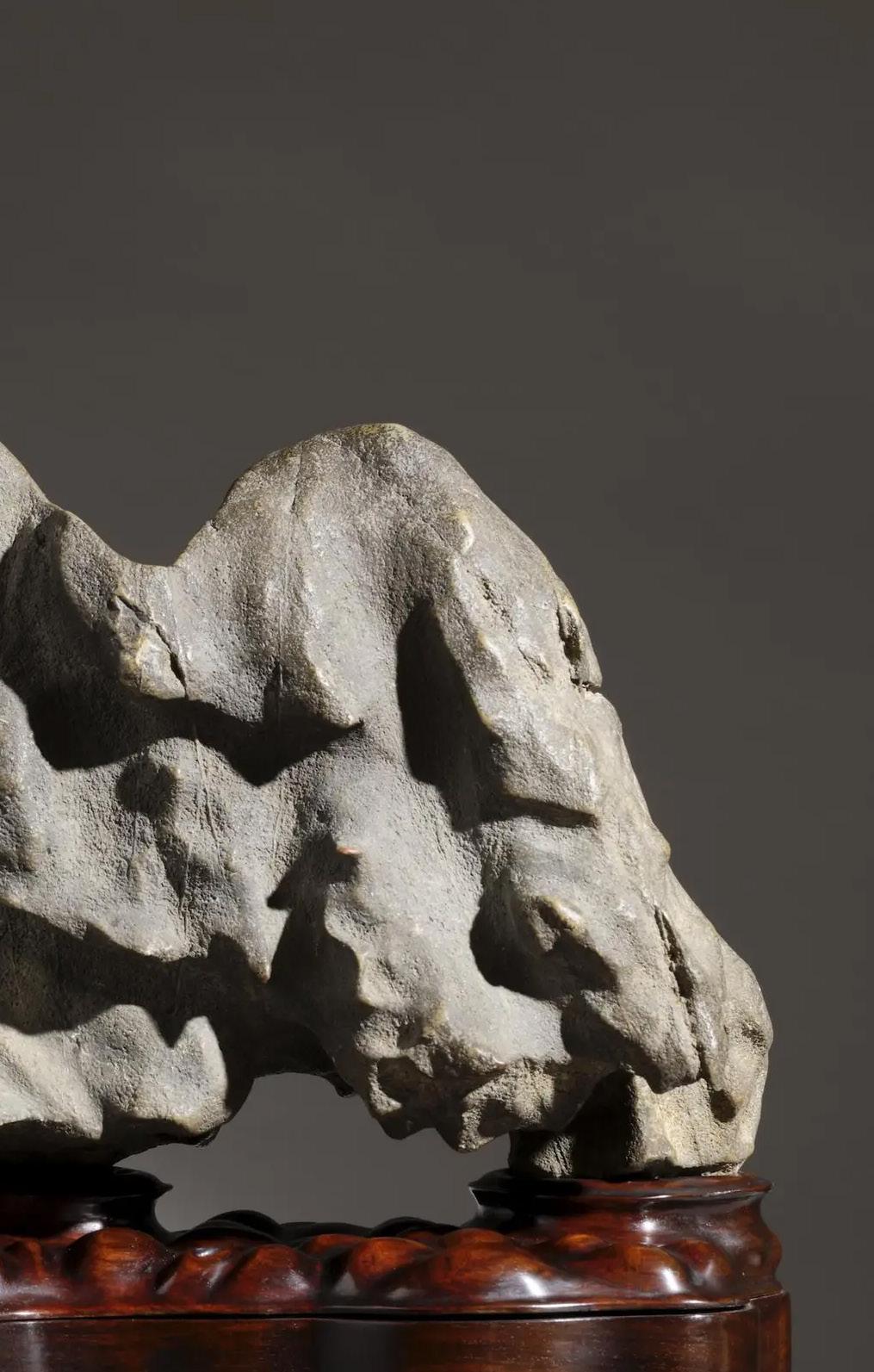
藍理捷,2003年展覽,錯金銅臥駱駝形鎮 西漢
Bronze weights in the form of compactly modelled animals are a well-known feature of the repertoire of the Han sculptor. Many examples in the form of coiled tigers, bears, rams, deer, phoenixes and dragons have been published, but no other Han bronze weight in the form of a recumbent camel appears to have been previously recorded except an inlaid camel weight exhibited in J.J.Lally exhibition in 2003.
For a discussion of different types of Han weights and their functions, see Sun Ji, ‘Han zhen yishu’ (Notes on the Arts and Crafts of Han Dynasty Weights), Wenwu, 1983, No. 6, pp. 69
銅臥駱駝形鎮
漢代(公元前206年-公元220年)
銅質厚重澆鑄,造型精妙絕倫,駱駝以靈動之姿臥伏,身軀陡然扭轉, 昂首高舉,氣勢生動,四肢收攏,緊貼平滑的身側。駝峰與四肢及尾部 如漢代神山聳起,神采奕奕,有霍去病墓雕塑之意象。
銅面鎏金保存完好,色澤鮮明。器底內填以鐵與鉛的混合金屬,用以加 重並起鎮物之用。
參考
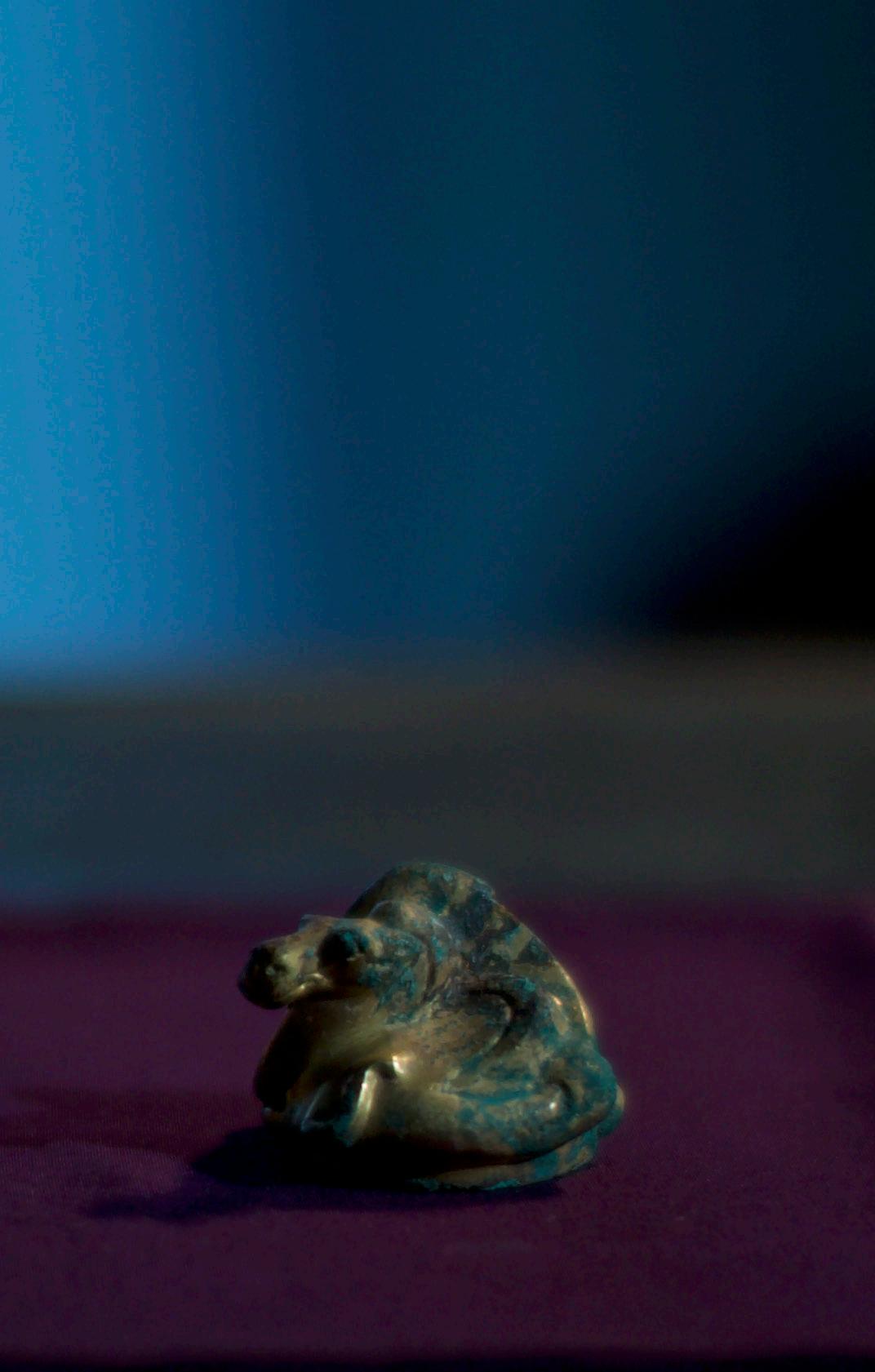
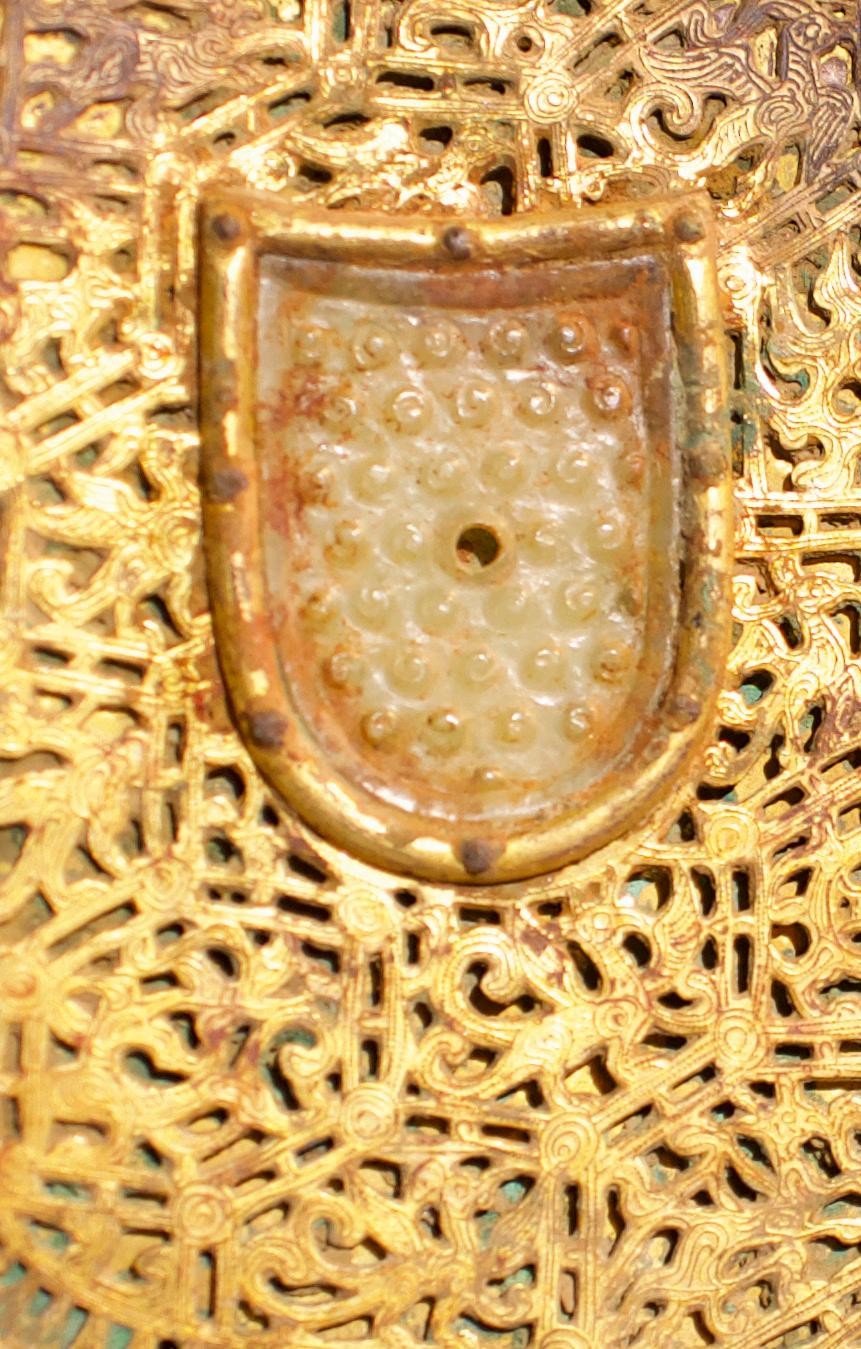
The arrow container, known as jianfu, was used in ancient times to store and protect arrows, ensuring that the arrowheads and shafts remained intact during transport. Designed for easy carrying and use, these containers played an important role in warfare and long-distance travel. The form and materials of the arrow container evolved throughout history, reflecting the ancient society’s high regard for the protection of arrows.
From the Shang to the Han dynasty, the design of arrow containers underwent several transformations.
During the Shang and Western Zhou periods, arrow containers were typically simple wooden vessels. By the Warring States period, arrow containers began to incorporate protective screens to safeguard the shafts and feathers of the arrows.
A typical example is the Warring States arrow container excavated from a tomb in Changsha, Hunan, which featured a lacquered wooden body with arrowheads inserted at the bottom and a screen at the top to protect the arrows.
In the Han dynasty, the design became even more varied, with the wooden arrow container from the Mawangdui Han tomb displaying fork-like points on its sides. The cylindrical arrow containers discovered in the tomb of the Terracotta Army and the Yin Ruins were often made of leather or wood, with flat bottoms that could hold approximately ten arrows with the arrowheads pointing downwards. Additionally, the Han dynasty arrow container from the Le Lang tomb, covered with silver foil, demonstrates the fine craftsmanship and decoration of arrow containers during this period.
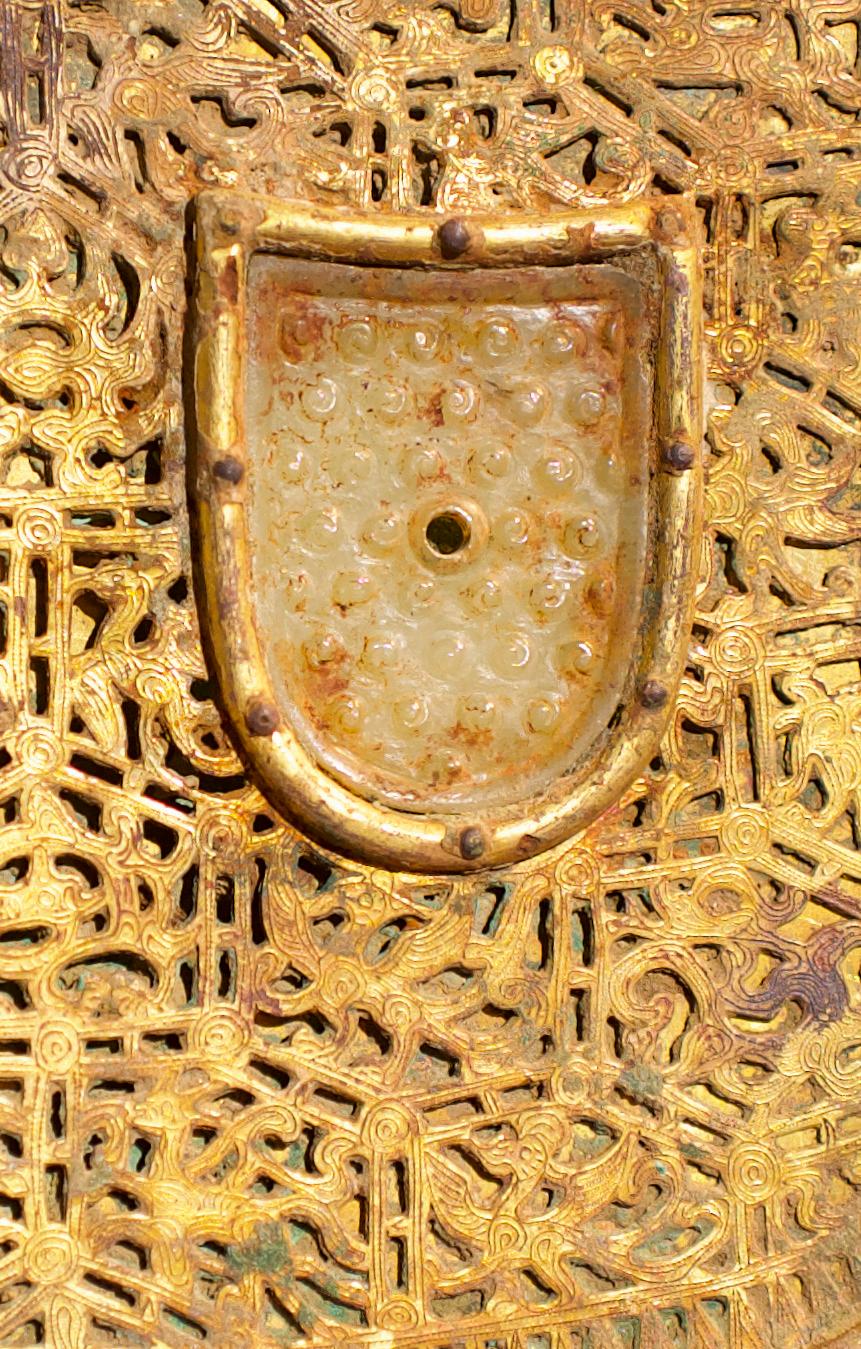
箭菔是古代用於盛裝和保護箭矢的容器,主要功能是確保箭頭和箭桿在運輸過程中 不受損壞。它通常被設計為便於攜帶和使用的結構,尤其在戰爭或長途旅行中具有重 要意義。
箭菔的形制和材質隨著歷史的演變而有所不同,反映了古代社會對箭矢保護的高度 重視。
從商朝到漢朝,箭菔經歷了多個階段的演變。商朝和西周時期的箭菔通常是簡單的木 質容器,而戰國時期的箭菔則開始出現帶屏風的設計,以保護箭桿和箭羽。
長沙楚墓出土的戰國箭菔是一個典型實例,採用塗漆木胎,下部插入箭頭,上部設有 保護屏風,能容納8支箭。
進入漢朝,箭菔的設計更加多樣,出現了如馬王堆漢墓出土的木箭菔,具有叉狀尖角, 造型更加精緻。秦始皇兵馬俑和殷墟遺址出土的圓筒狀箭菔則多采用皮革或木材製 作,底部為平面,能容納約10支箭矢,箭頭向下排列。此外,樂浪古墓出土的漢代箭 菔,採用外貼銀箔的漆筒,進一步展現了漢代對箭菔的精緻化製作與裝飾。
AN INLAID GILT-BRONZE CAMEL-FORM WEIGHT HAN DYNASTY (206 BC-AD 220)
The exquisite arrow case decoration is adorned with two Han Dynasty jade plate featuring grain patterns.
The pierced gilded panels are intricately carved with dragons, phoenixes, birds, deer, and other rare and mythical creatures, showcasing exquisite craftsmanship. It is highly possible that such delicate design was imperial, intended as a decorative piece for royal hunting events.
鎏金鏤空神獸紋鑲谷紋玉璧菔飾 漢代(公元前206年-公元220年)
箭菔飾中高等級的製品,鑲有兩枚隨型的漢代谷紋玉璧。鏤空的鎏金 面板上刻畫有 龍、鳳、鳥、鹿等 珍禽異獸,工藝精絕,或為皇族狩獵時 的菔飾。
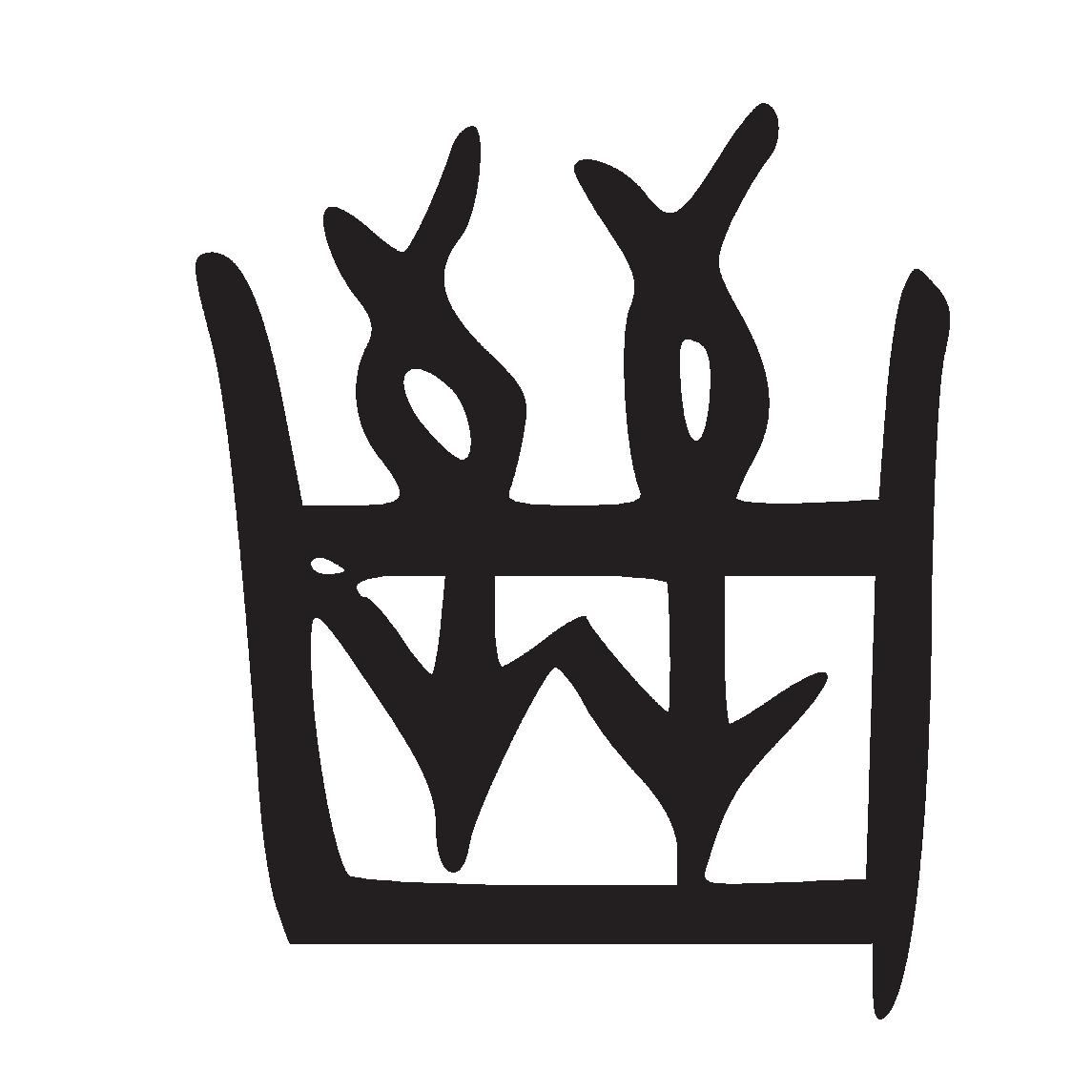

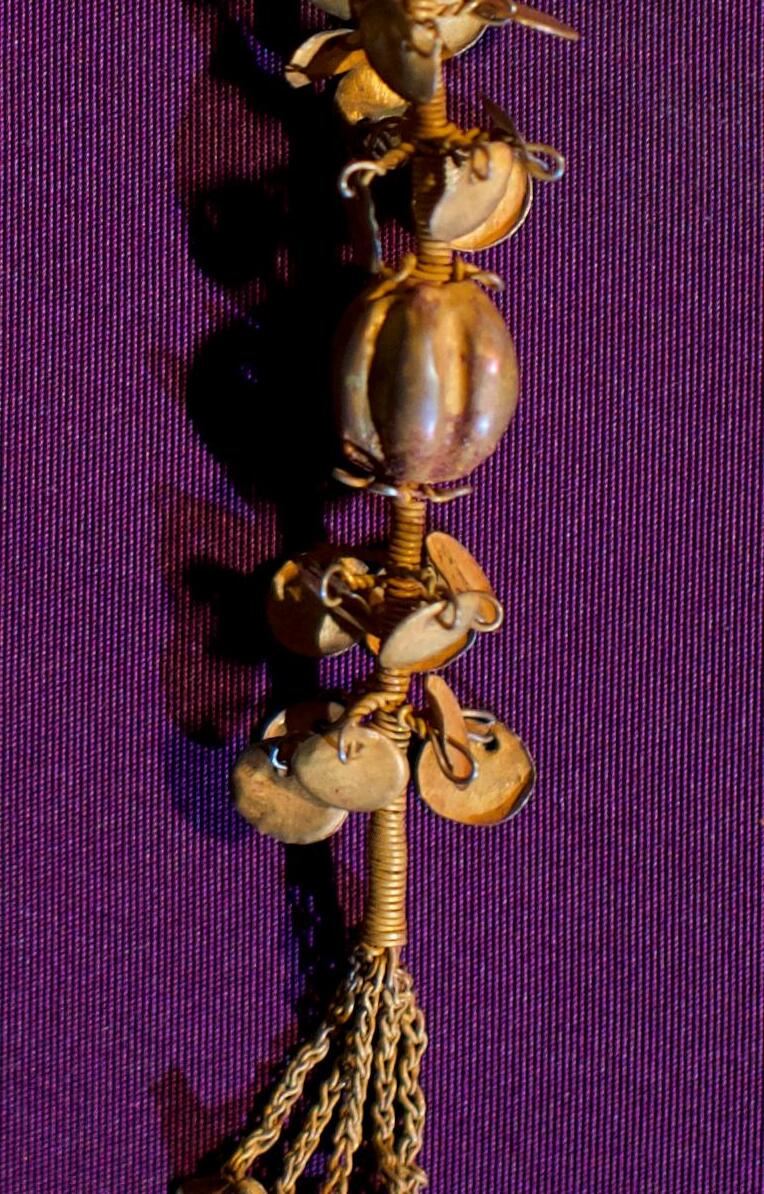
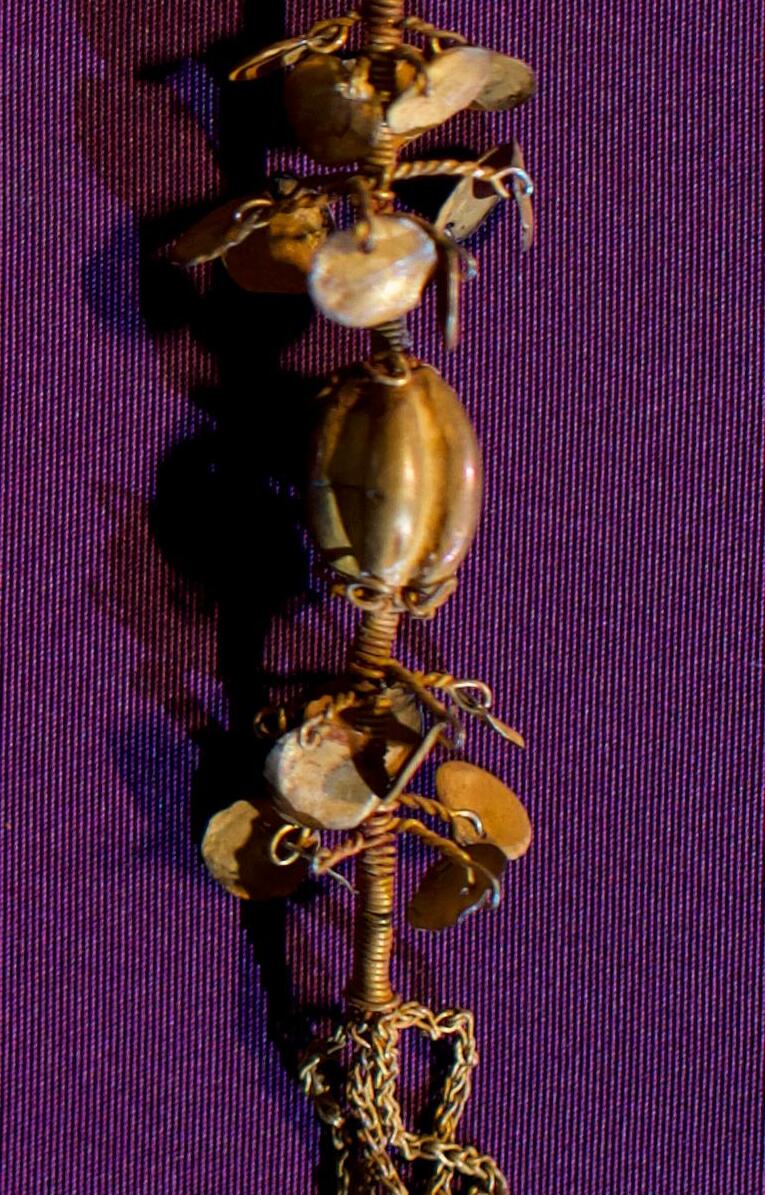
珠形瓜稜金耳墜一對
北魏(公元 1368年- 1644年)
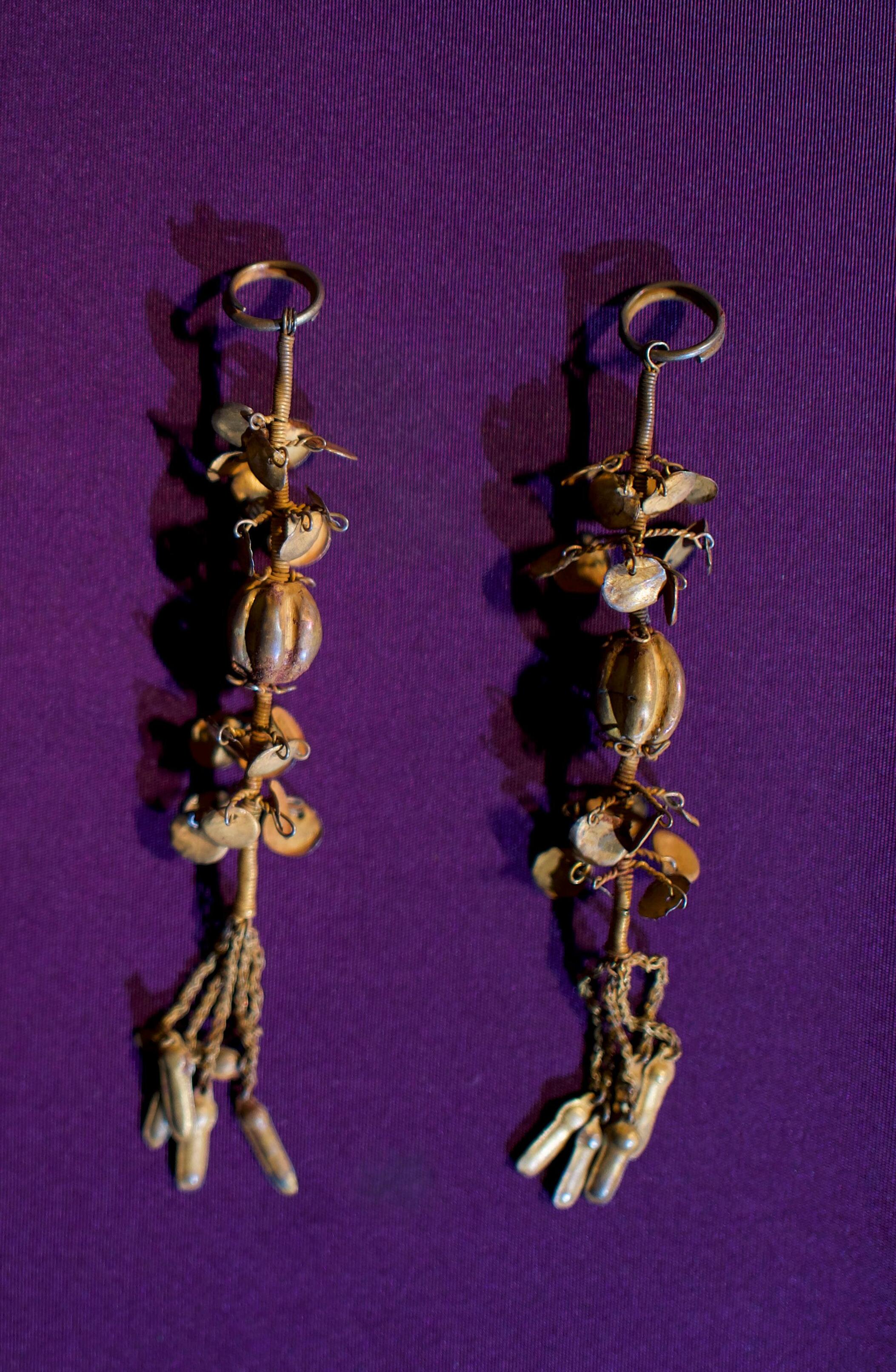
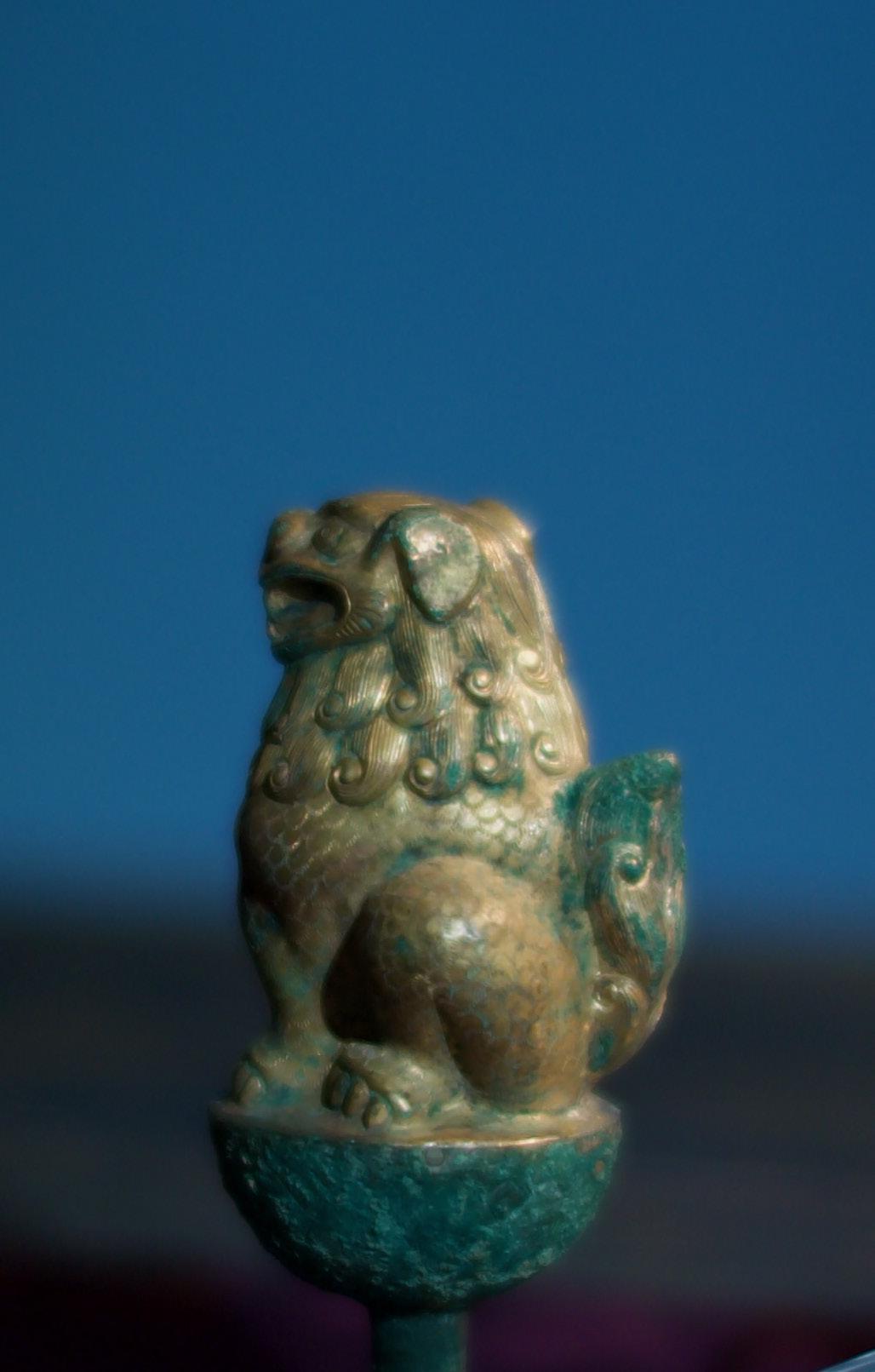
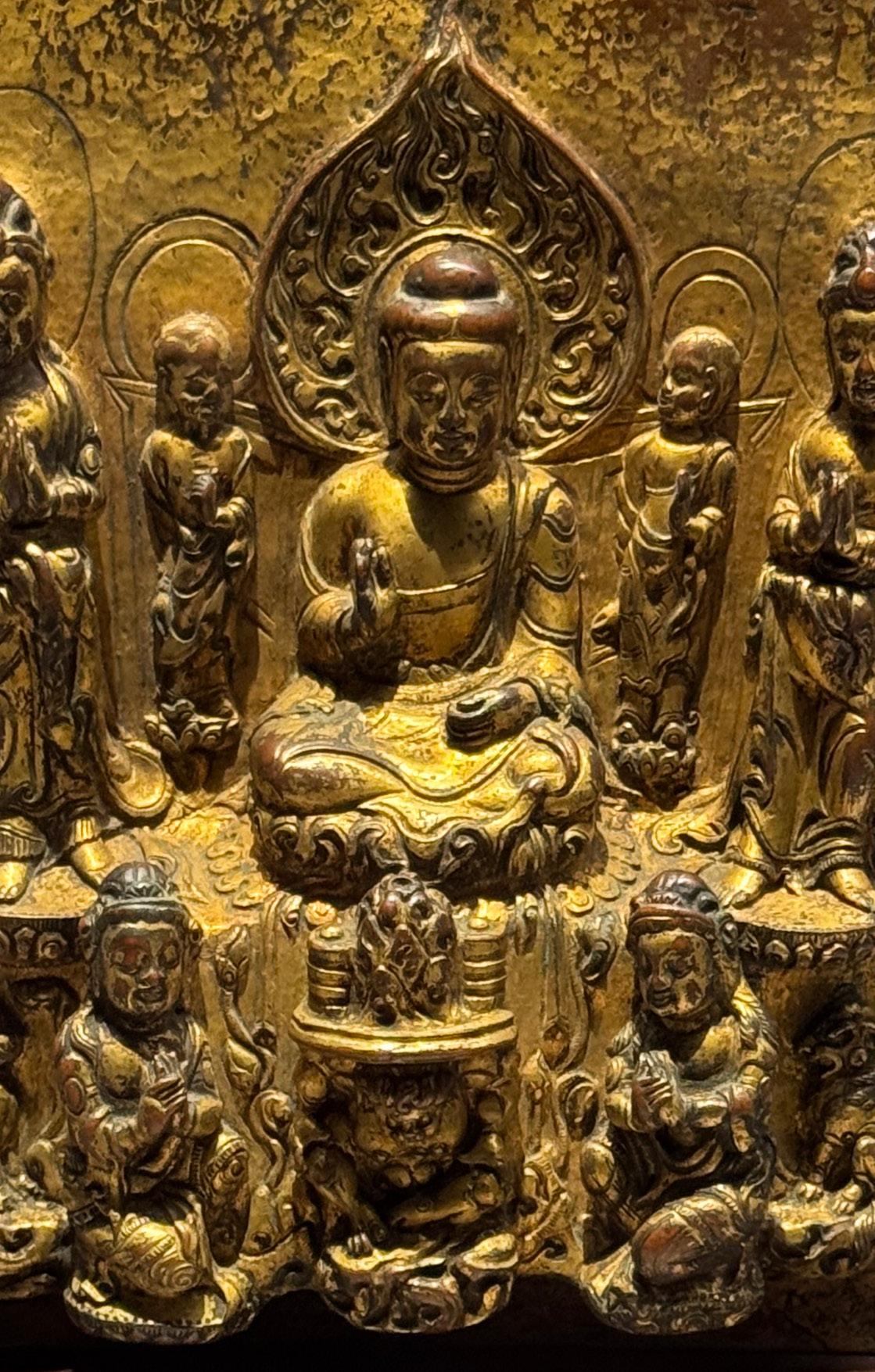
純金鎚鍱蝶工藝打造的護法獅極為罕見,類似的工藝可見何家村窖藏出土的一例「仰 蓮瓣座銀罐」。
該罐由兩部分組成,上部為罐形,下部似一圓底碗,底座飾仰蓮瓣一周,各蓮瓣中央鏨 刻一心形圖案。罐體和仰蓮座分別制好再拼接而成。這種器物形制特殊,此前僅見於 何家村窖藏。
對比蓮座與其承載物的連結手法,可以推測這是同一種罕見的焊接製作工藝。整體製 作之鎚鍱工藝,則可以參考根津美術館所藏的極為罕見的唐代鎚鍱鎏金五尊佛像。鎚 鍱(chuí yè)像是一種具有高度技術性和藝術價值的金屬工藝品,通過將薄銅板壓於 模具上並以槌擊成型,創造出具有浮雕效果的佛像或其他工藝品。
此技法源自中國,並在隋唐時期達到高度發展,對日本的飛鳥及奈良時代的佛像製作 產生了深遠影響。
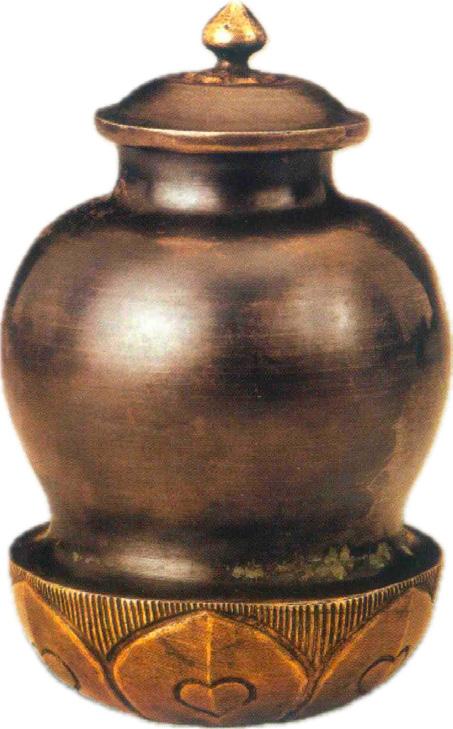
The craftsmanship is extremely rare and exquisitely made. The lion’s form exudes a mighty Tang Dynasty presence, with its tail fully raised and its posture commanding an imposing aura.
This guardian lion is unique in terms of craftsmanship, spiritual significance, and design; it is the only known example of its kind.
純金鎚鍱護法獅帶蓮座 唐代(公元618年-907年)
工藝極為罕見,製作精美,獅子造型頗有大唐威猛之勢,尾部飽滿聳 起,氣勢凌厲。這件護法獅工藝、精神內涵、形制都極為特殊,目前僅 見此例。
參考:
何家村窖藏「仰蓮瓣座銀罐」
《大唐遺寶:何家村窖藏出土文物展》,第六十三頁。
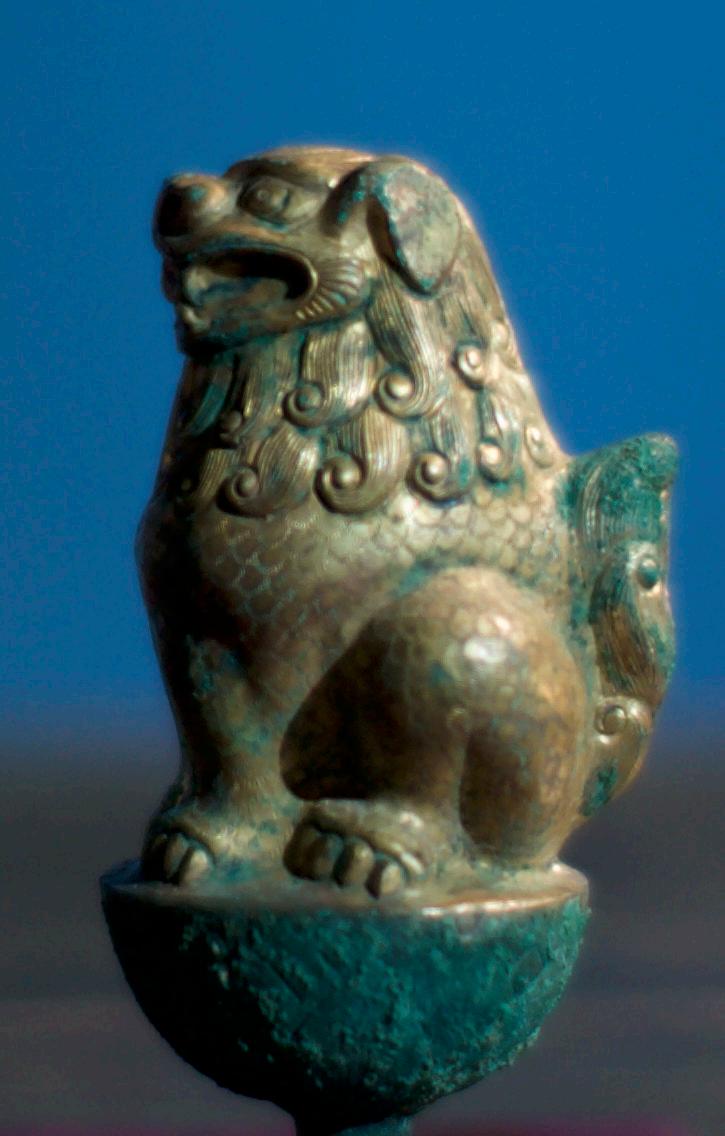

Gold-plated repoussé guardian lion created using repoussé techniques is extremely rare. A similar technique can be seen in the “Lotus Petal-Base Silver Jar” discovered in the Hejia Village tomb.
The jar consists of two parts: the upper part is jar-shaped, and the lower part resembles a round-bottom bowl. The base is decorated with a ring of upward-facing lotus petals, each with a heart-shaped pattern carved at the center. The jar body and the lotus seat were made separately and then joined together. This type of vessel is unique and was previously only found in the Hejia Village tomb.
By comparing the method of connecting the lotus seat with its base, it is inferred that the same rare welding technique was used. The overall repoussé craftsmanship can be compared to the extremely rare Tang Dynasty gilded repoussé five-figure Buddha statues in the Nezu Museum.
Repoussé (鎚鍱, chuí yè) is a highly technical and artistic metalworking technique where thin copper sheets are pressed over a mold and then hammered to form raised, sculptural figures such as Buddhas or other artworks.
This technique originated in China and reached its peak during the Sui and Tang Dynasties, profoundly influencing the creation of Buddhist statues in Japan’s Asuka and Nara periods.
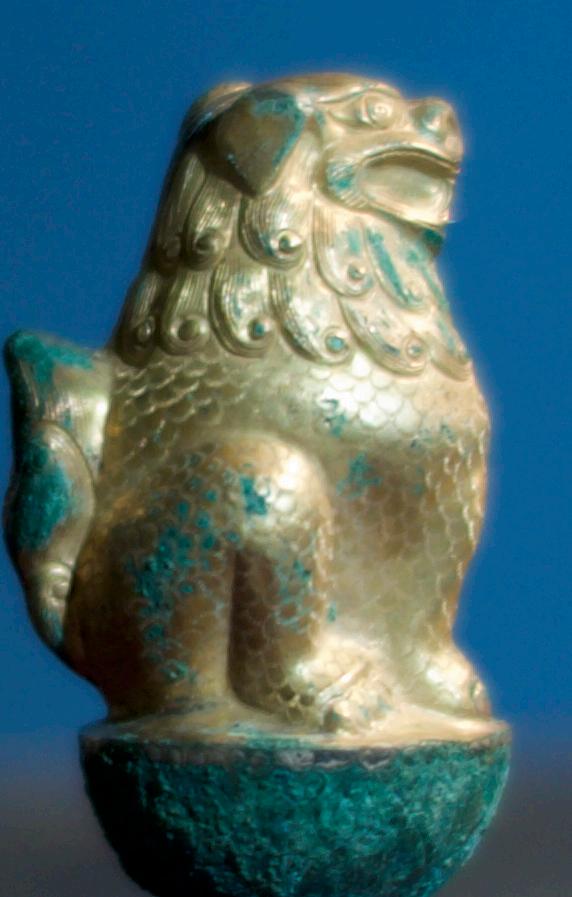
The opulence of the Tang court is reflected not only in the use of gold and silver for the manufacture of vessels, but also for the decoration of everyday objects and personal adornment. For the ladies of the court this included rich jewelry such as necklaces, earrings and bracelets, as well as combs and hairpins that adorned their hair styles, which became more elaborate as the dynasty progressed. Later in the Tang period the ends of the hairpins were often made from thin sheet silver with cut-out designs that made them light in weight and, along with the addition of gilding, made the hairpins shimmer and quiver as the woman moved.
The present hairpins are decorated with a pair of phoenix, the symbol of the empress who embodied all feminine attributes. See a similar example in Royal Ontario Museum.
銀鎏金鏤空鳳凰髮釵
唐代(公元618年-907年)
唐代宮廷的奢華,不僅體現在金銀器皿的製作上,也展現在日常用品 與個人裝飾的華麗點綴之中。對於宮廷女性而言,這包括了項鍊、耳 環、手鐲等華美首飾,以及梳篦與簪釵等髮飾。隨著王朝的發展,女性 的髮式愈加繁複,而在唐代後期,簪釵的簪首常以薄銀片製成鏤空紋 飾,不僅重量輕盈,加之鎏金工藝,更能在佩戴者舉止間閃爍生輝,微 微顫動,平添風姿。
本簪釵裝飾一對鳳凰,是皇后的象徵。參考,皇家安大略博物館一件 同款。
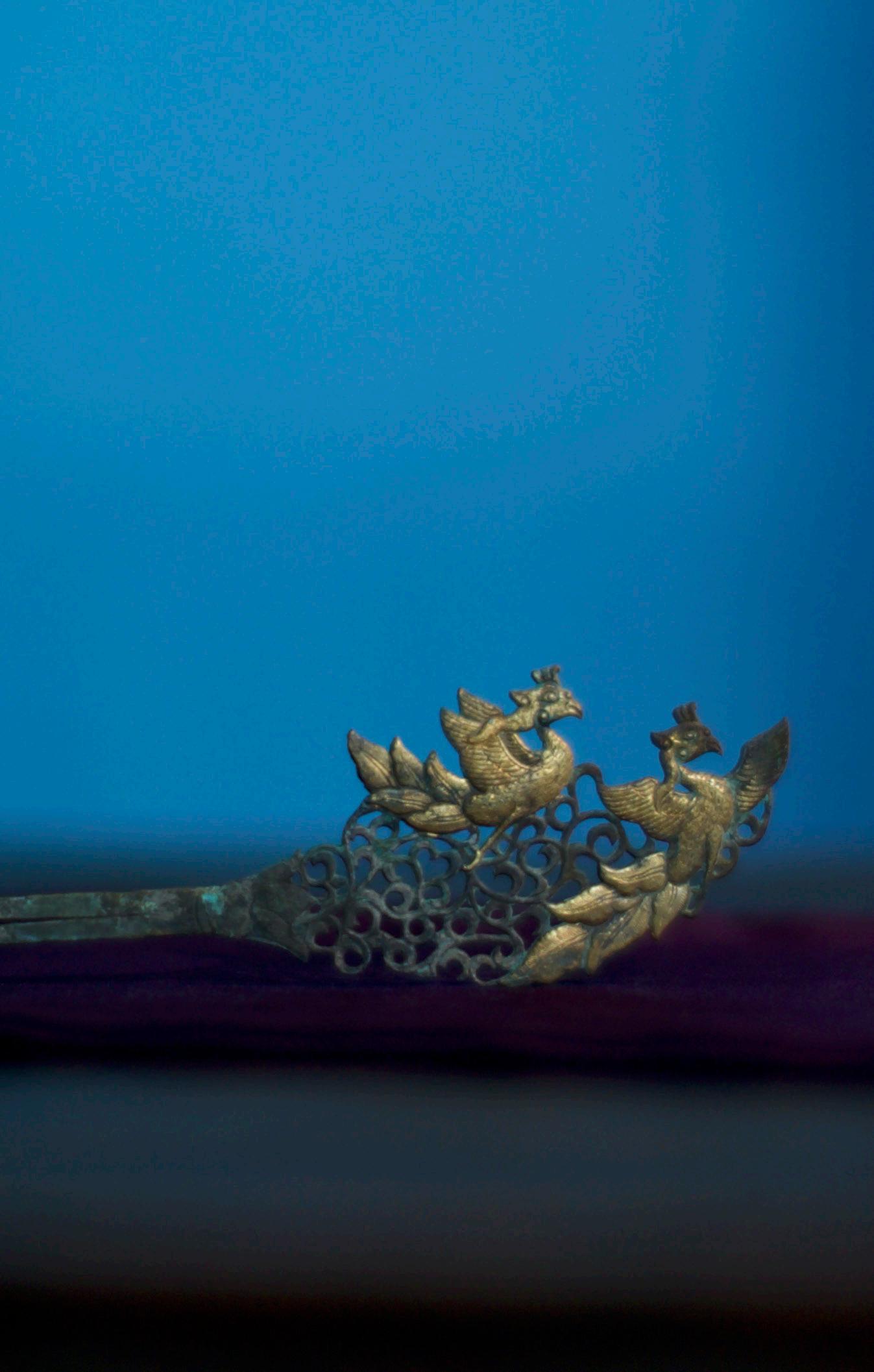

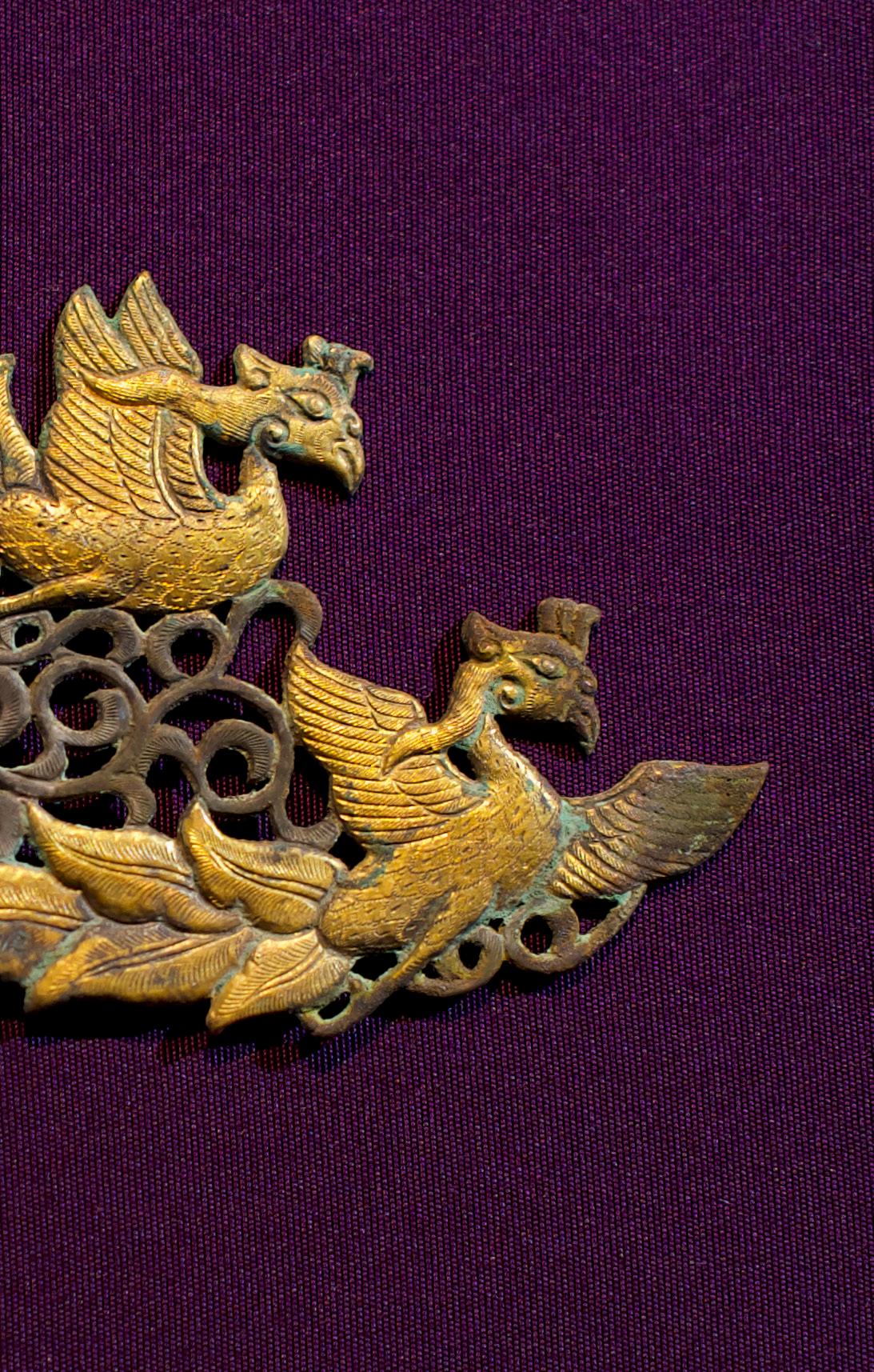
器物腹壁上的蓮瓣紋飾來自西域金銀 器工藝的影響。
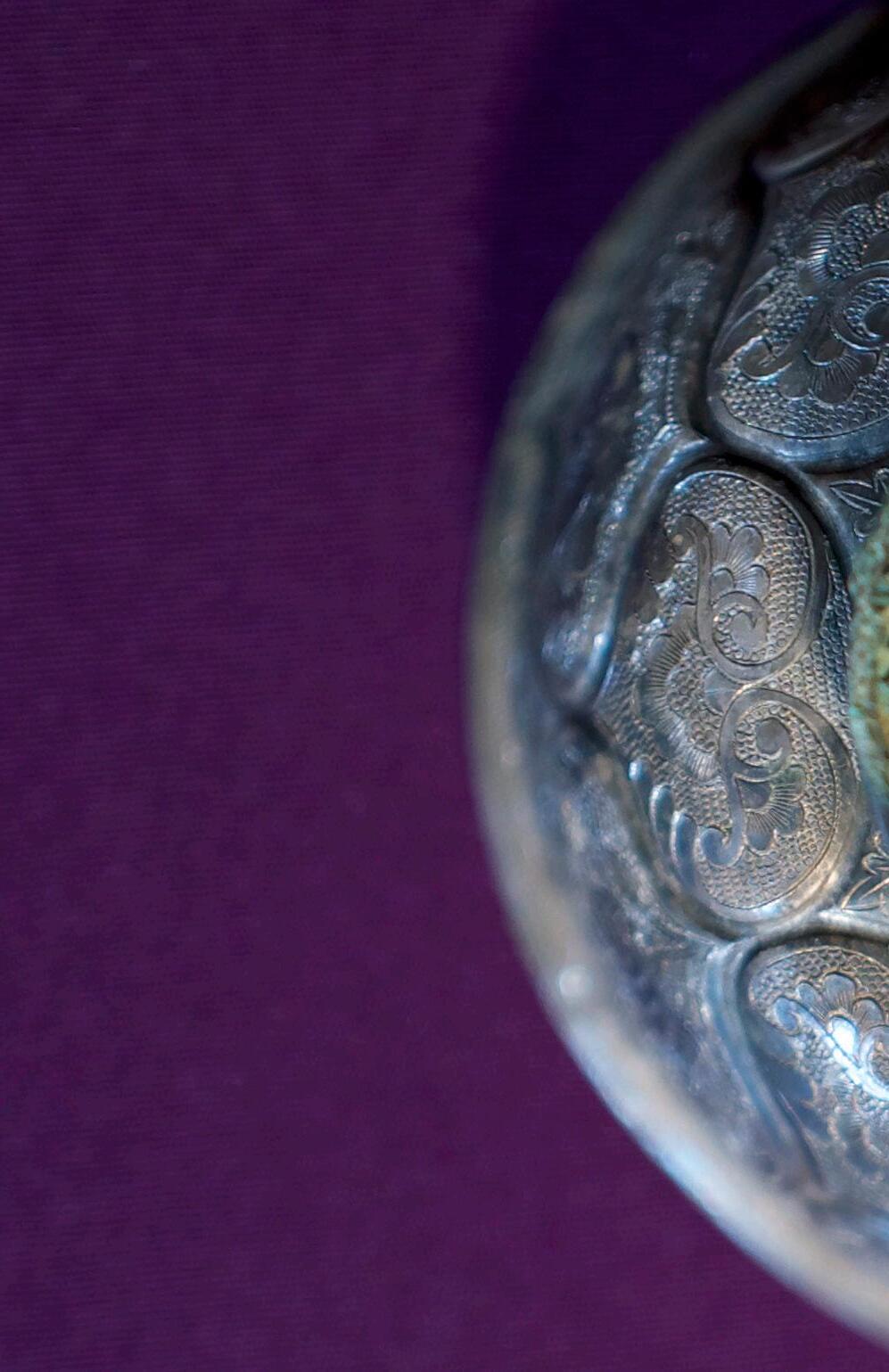
團花與大雁紋樣,則屬東方審美之融 合,延展出大唐帝國文化交流中的微妙 平衡與藝術主張 ⋯
The lotus petal motif on the vessel’s belly reflects the influence of Western metalwork. The arabesque floral patterns and the wild goose design, however, belong to the Eastern aesthetic, embodying a fusion that extends the subtle balance and artistic principles within the cultural exchanges of the Tang Empire.
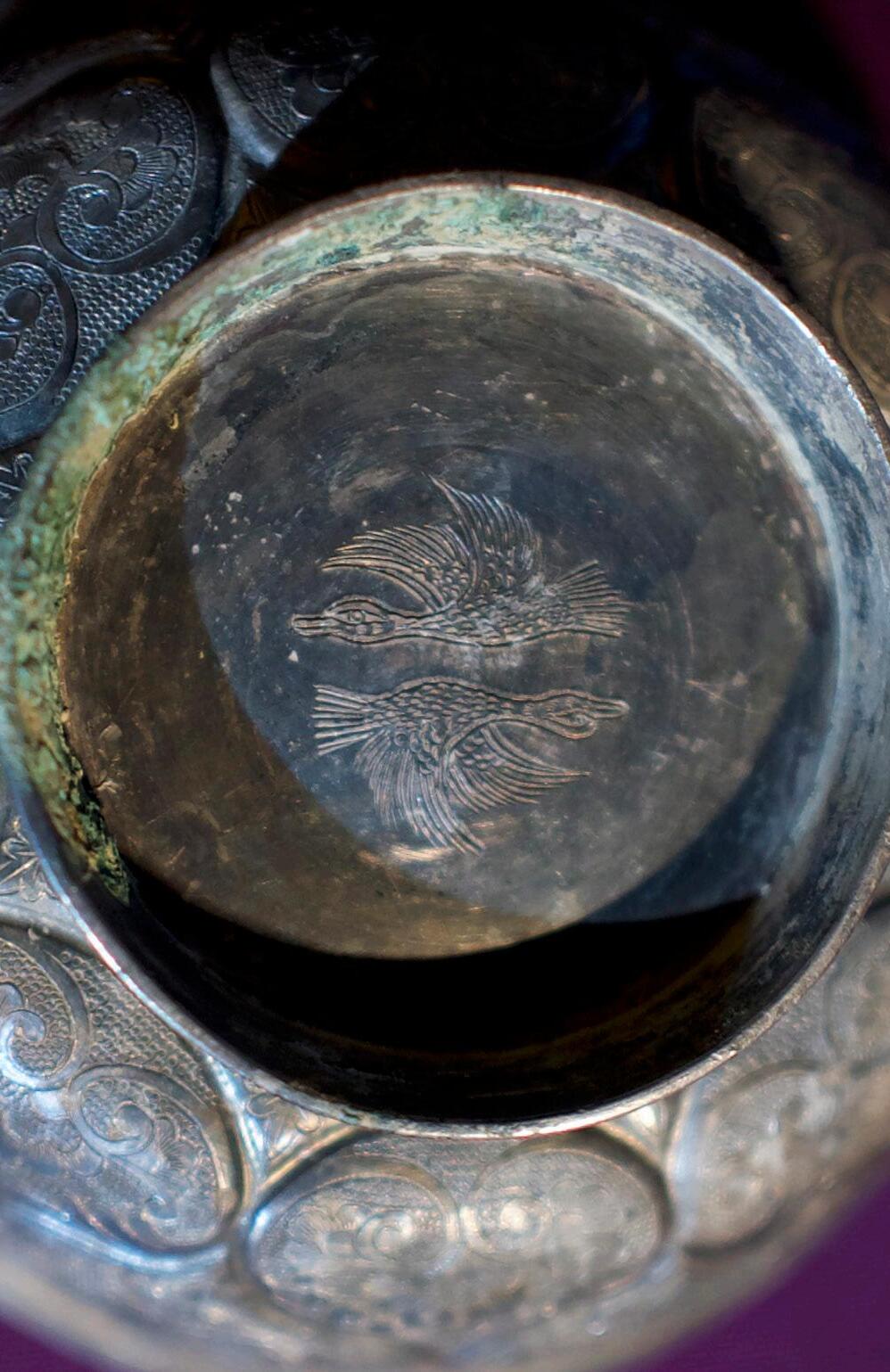
The silver bowl is exquisitely crafted in repoussé, with two rows of overlapping lotus petals. The lower row is finely chased with leafy plants, while the higher row showcases exquisitely chased animals in motion, set against a background of dense leafy sprays.
Above this, there is a further row of smaller repoussé petals, alternating with clusters of stamen, beneath slender lanceolate leaf tips that point towards the everted rim. The inner center of the rim base is decorated with a pair of flying geese.
鏨花動植物紋銀碗 唐代(公元618年-907年)
這只銀碗精緻地以鎚擊浮雕工藝製作,碗身下部有兩排重疊的荷葉花 瓣,下排以植物圖案精緻地錘刻,較高的花瓣排則以動態的動物圖案 精雕細刻,背景是由茂密的葉片和藤蔓所構成。
上方還有一排較小的浮雕花瓣,花瓣之間穿插著花蕊,並配有修長的 劍葉形葉尖,葉尖指向碗口外翻的邊緣。碗的圈足中央,裝飾有一對飛 翔的大雁。
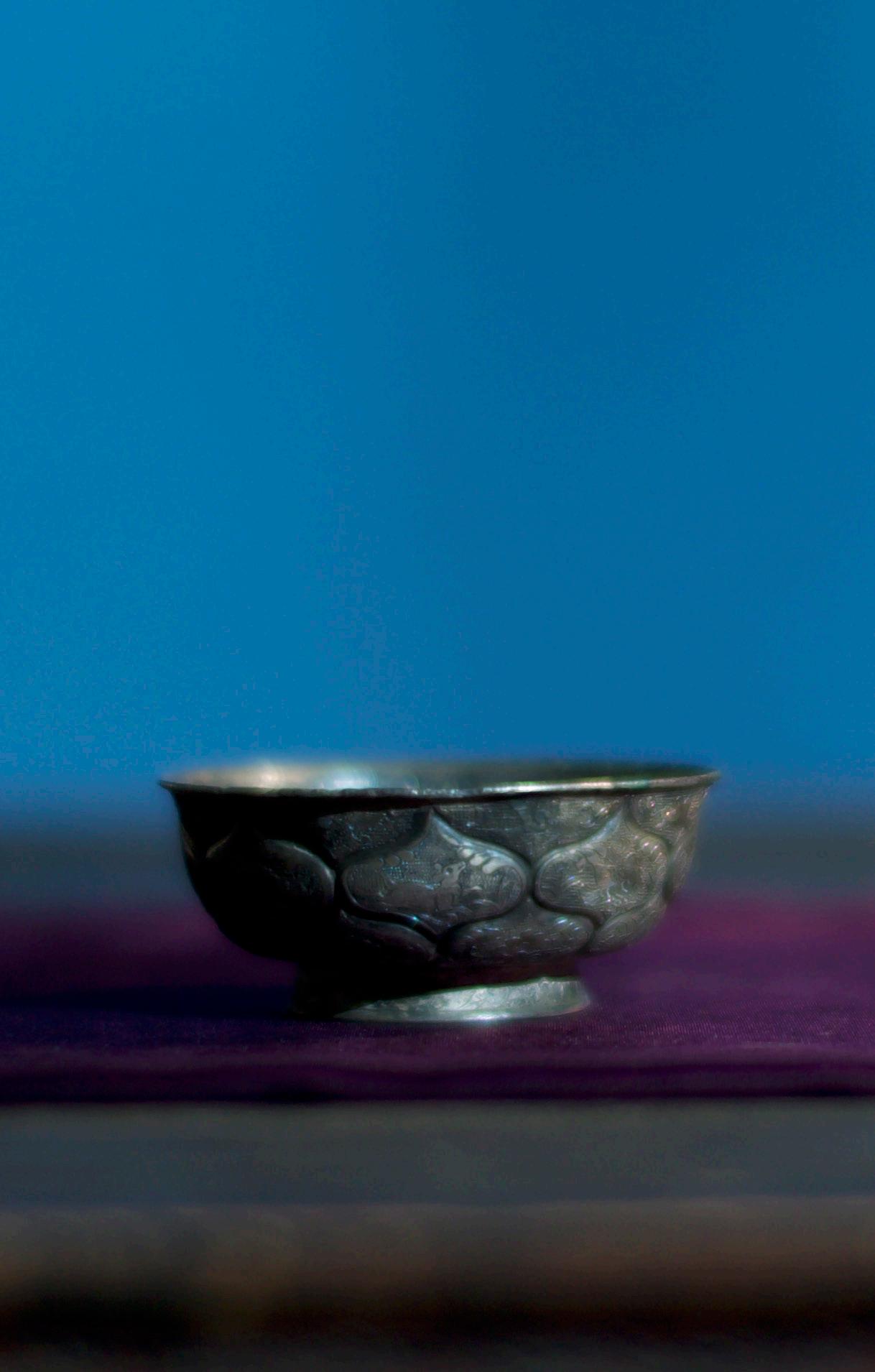
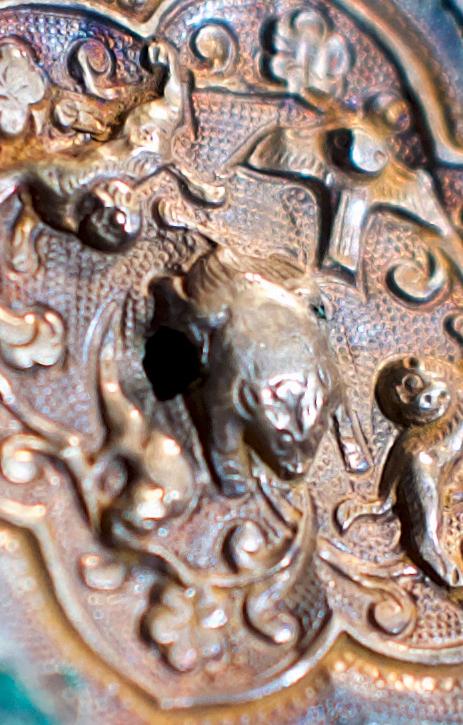
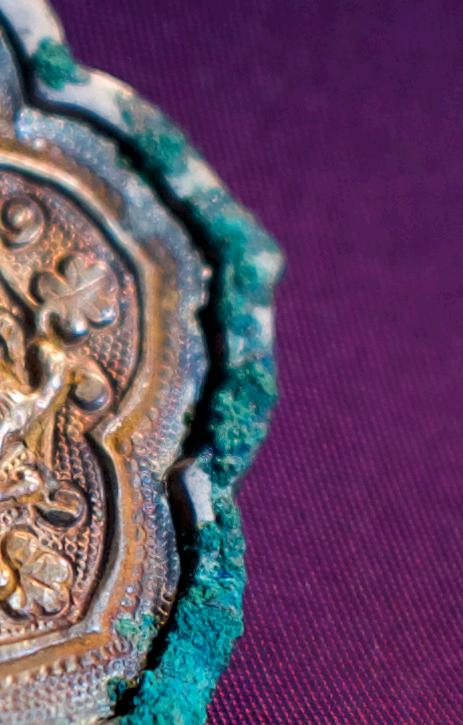
A similar mirror of comparable small size (6 cm.) is illustrated in Ancient Bronze Mirrors from the Shanghai Museum, Shanghai, 2005, pp. 236-7, no. 80; and two others of comparable size are illustrated in Luoyang chutu tongjing (Bronze Mirrors Excavated in Luoyang), Beijing, 1988, nos. 115 and 116.
See, also, the similar mirror illustrated by T. Nakano et al., Bronze Mirrors from Ancient China: Donald H. Graham Jr. Collection, 1994, pp. 230-1, no. 85, where the authors note that the practice of decorating the backs of bronze mirrors with silver or gilt-silver sheet with repoussé decoration is first seen in the Sui dynasty, but was most popular in the mideighth century on lobed mirrors. Miniature mirrors such as this were probably portable and carried by noblewomen.
銀背局部鎏金鳥獸紋菱花式掌中鏡
唐代(公元618年-907年)
尺寸相近(直徑6厘米)的銅鏡可參見《上海博物館藏古代銅鏡》,上 海,2005年,頁236-237,編號80;另有兩面尺寸相近的銅鏡,刊於《洛 陽出土銅鏡》,北京,1988年,編號115與116。
另參見中野尊正等著《唐鏡——唐代中國銅鏡》,Donald H. Graham Jr. 收藏,1994年,頁230-231,編號85。
書中作者指出,以鎏銀或鎏金銀片並施以錘揲浮雕工藝裝飾銅鏡背面 的做法,最早可見於隋代,而在八世紀中期的多瓣形銅鏡上最為盛行。
像本品這樣的小型銅鏡,應為便於攜帶,可能是貴族婦女的隨身用品。
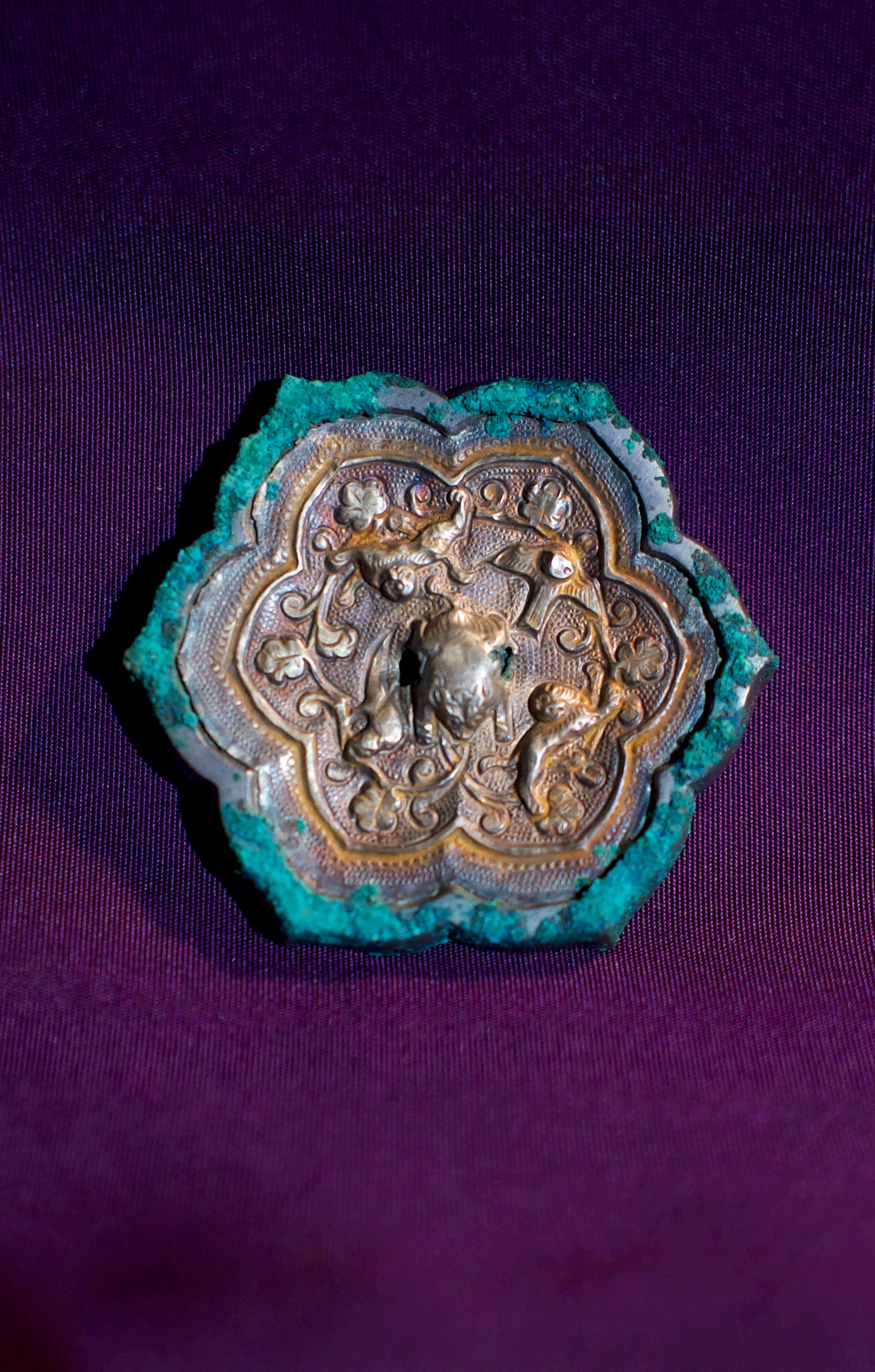

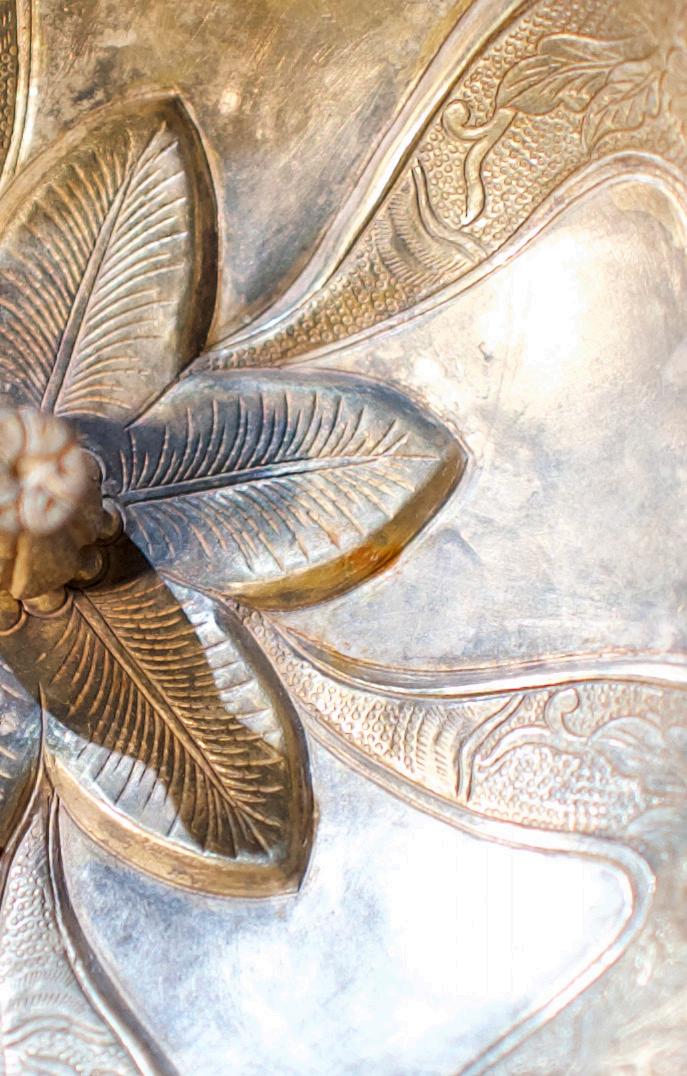
Silver Foliate Cup
During the Song Dynasty (960-1279), silver cups shaped like flowers, including hibiscus, were popular. These cups, often silver, were crafted in the form of open flowers with detailed petal designs, sometimes incorporating floral motifs like lotus and chrysanthemum. They were used for serving wine or liquor, reflecting the Song dynasty’s love for both flowers and banquets. 花型銀杯
宋代銀制杯具以花卉形狀為主流,其中包括木槿花形狀的杯子。這些 杯子通常採用金銀材質,呈開放的花朵形狀,花瓣的設計細緻入微,有 時還會融入蓮花、菊花等花卉圖案。
它們常用於盛酒或酒類,體現了宋代對花卉和宴會文化的喜愛。
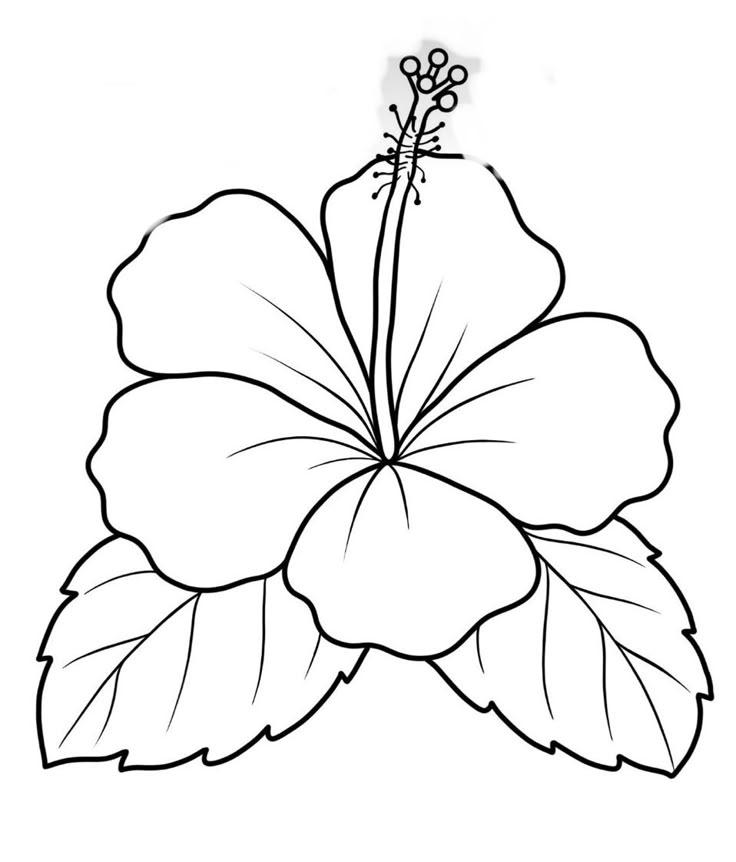
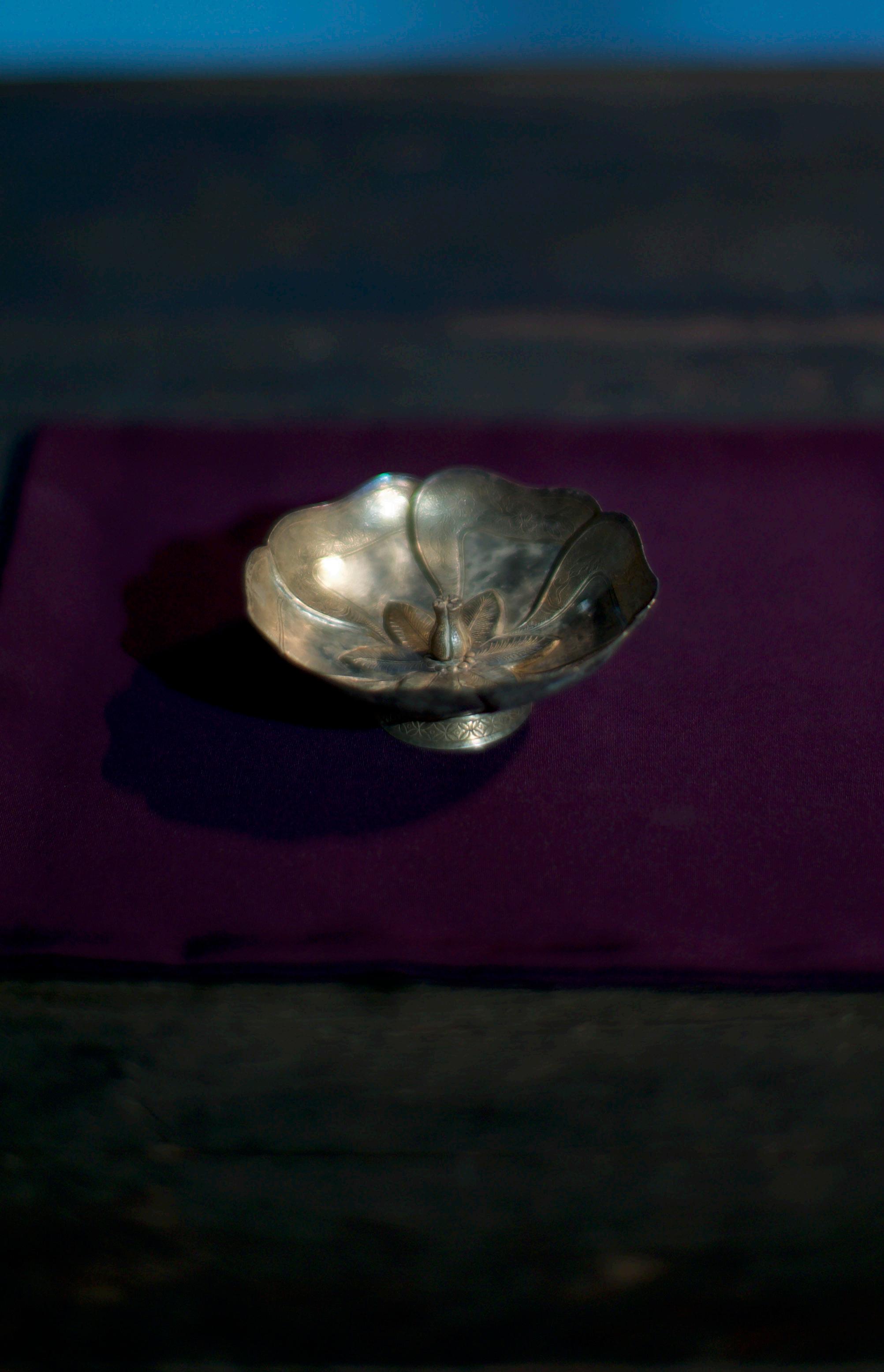
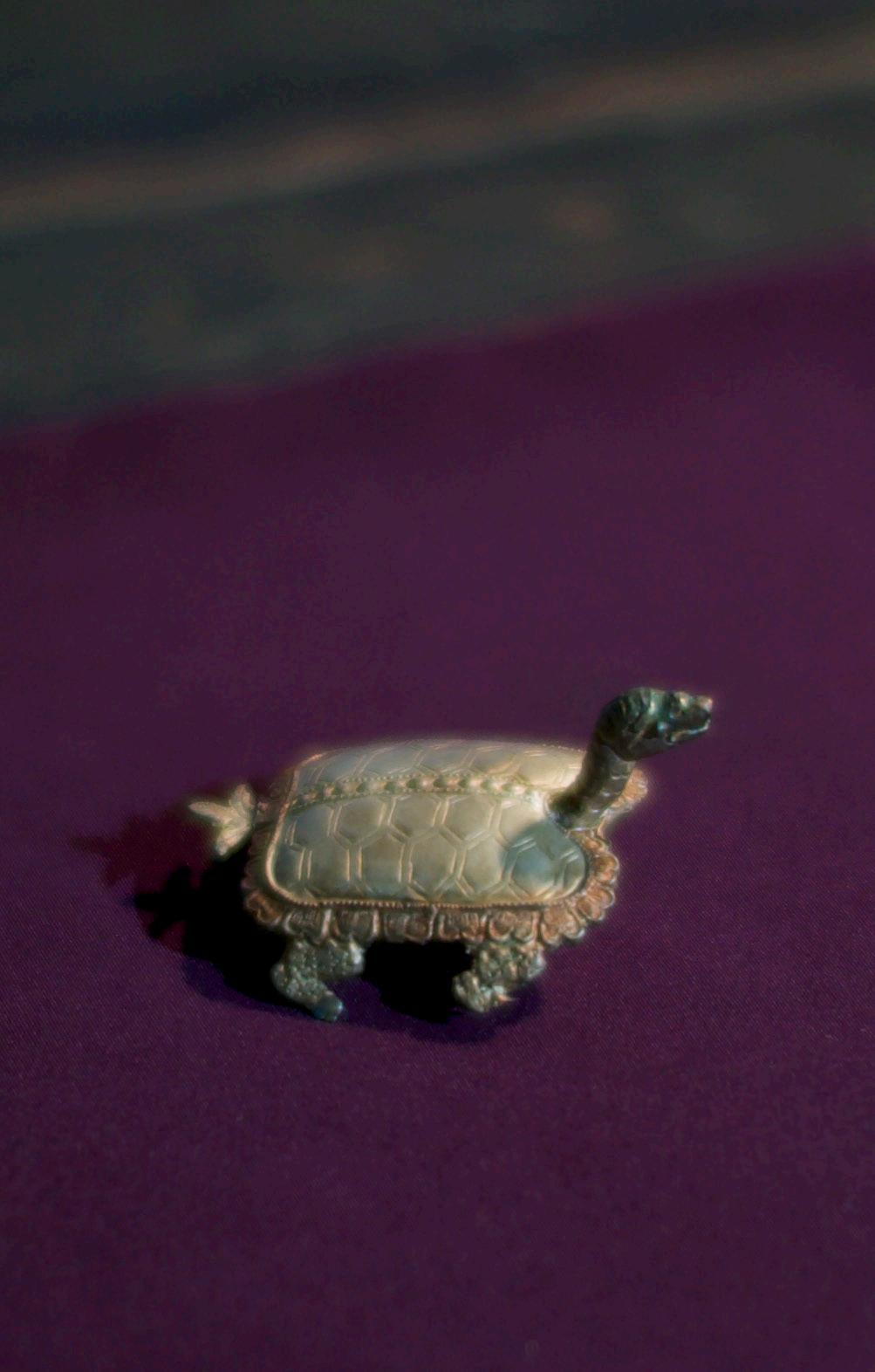
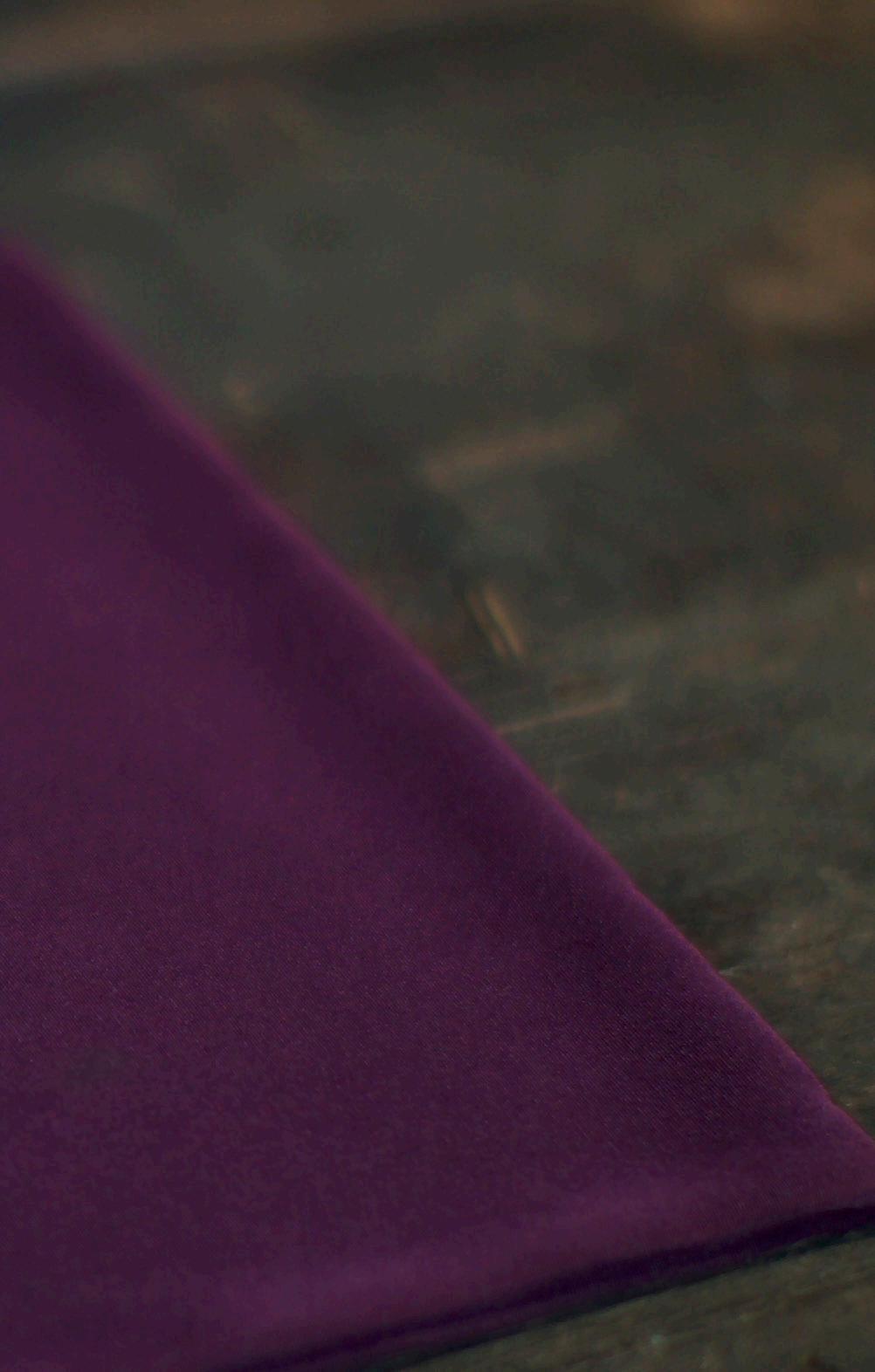
銀龜
宋代(公元 960年- 1279年)
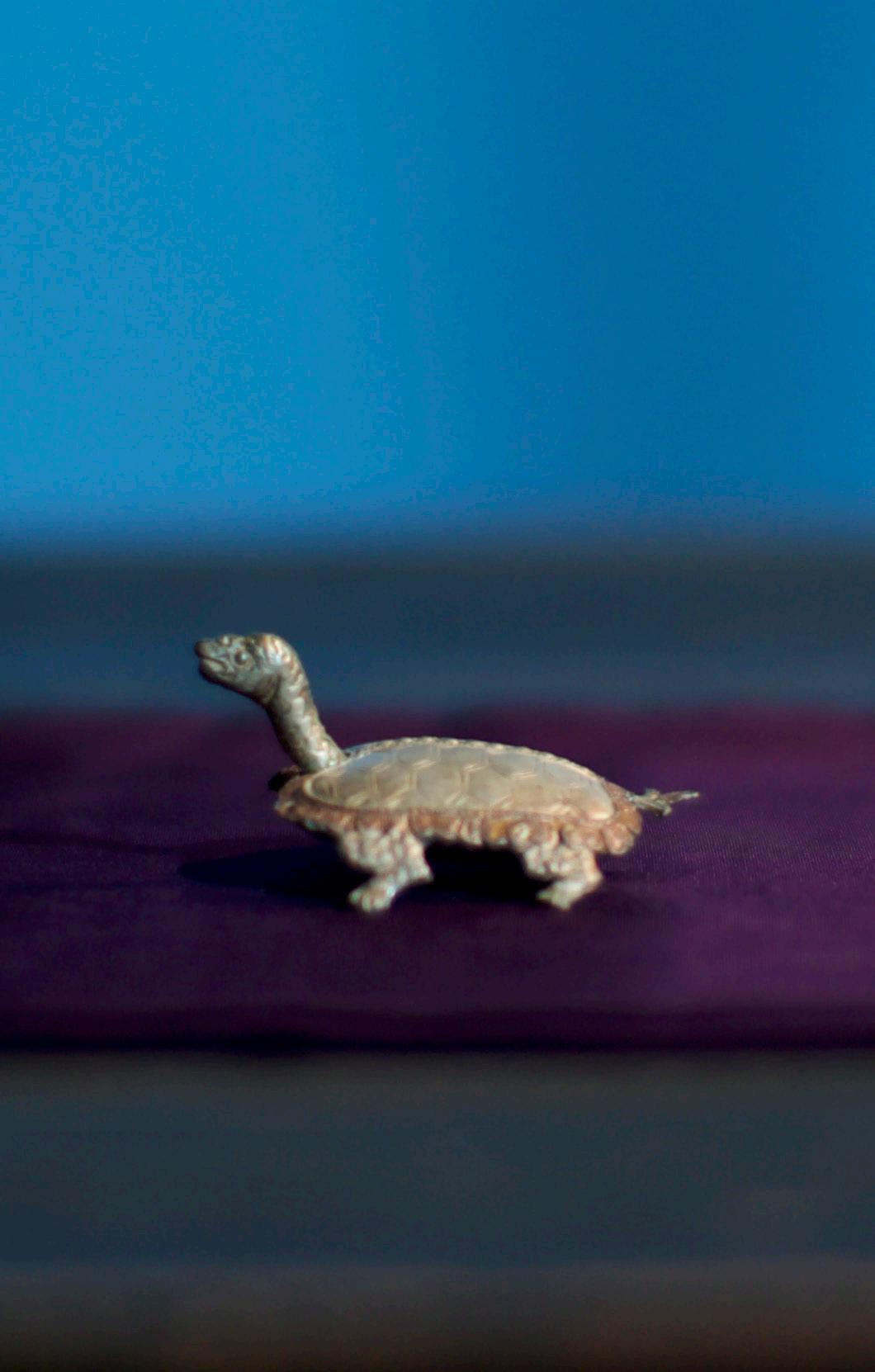
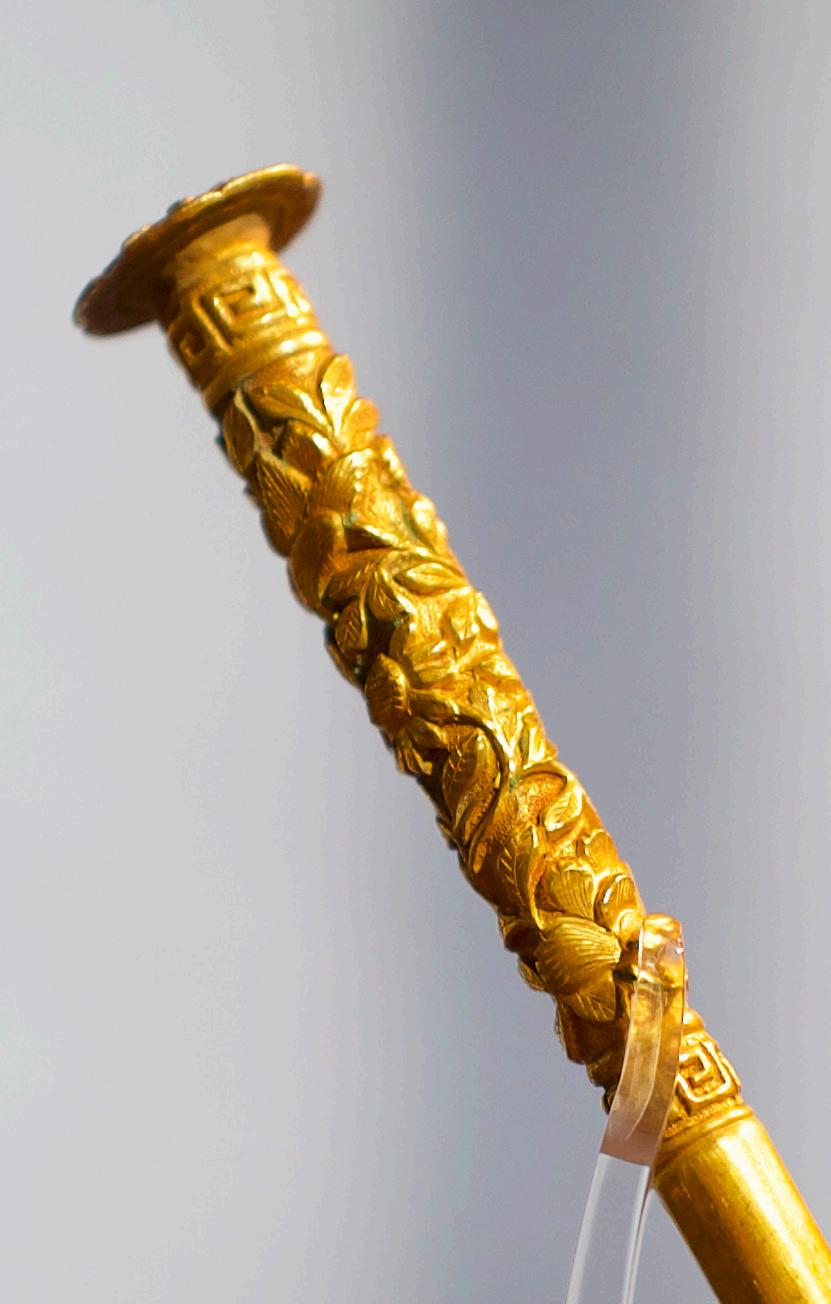
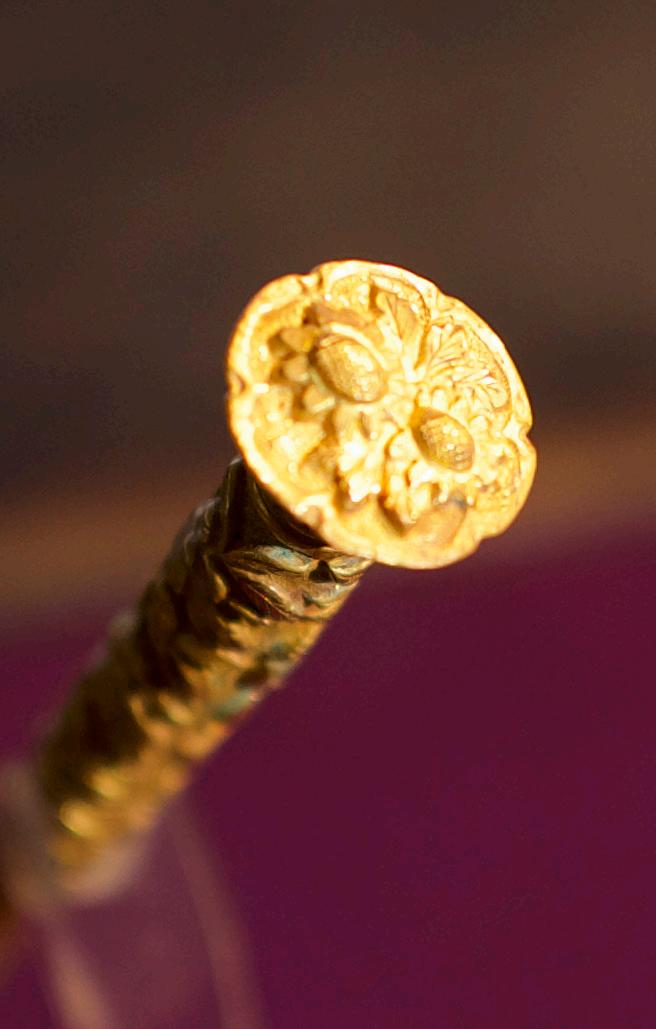
金釵一對
宋代(公元 960年- 1279年)
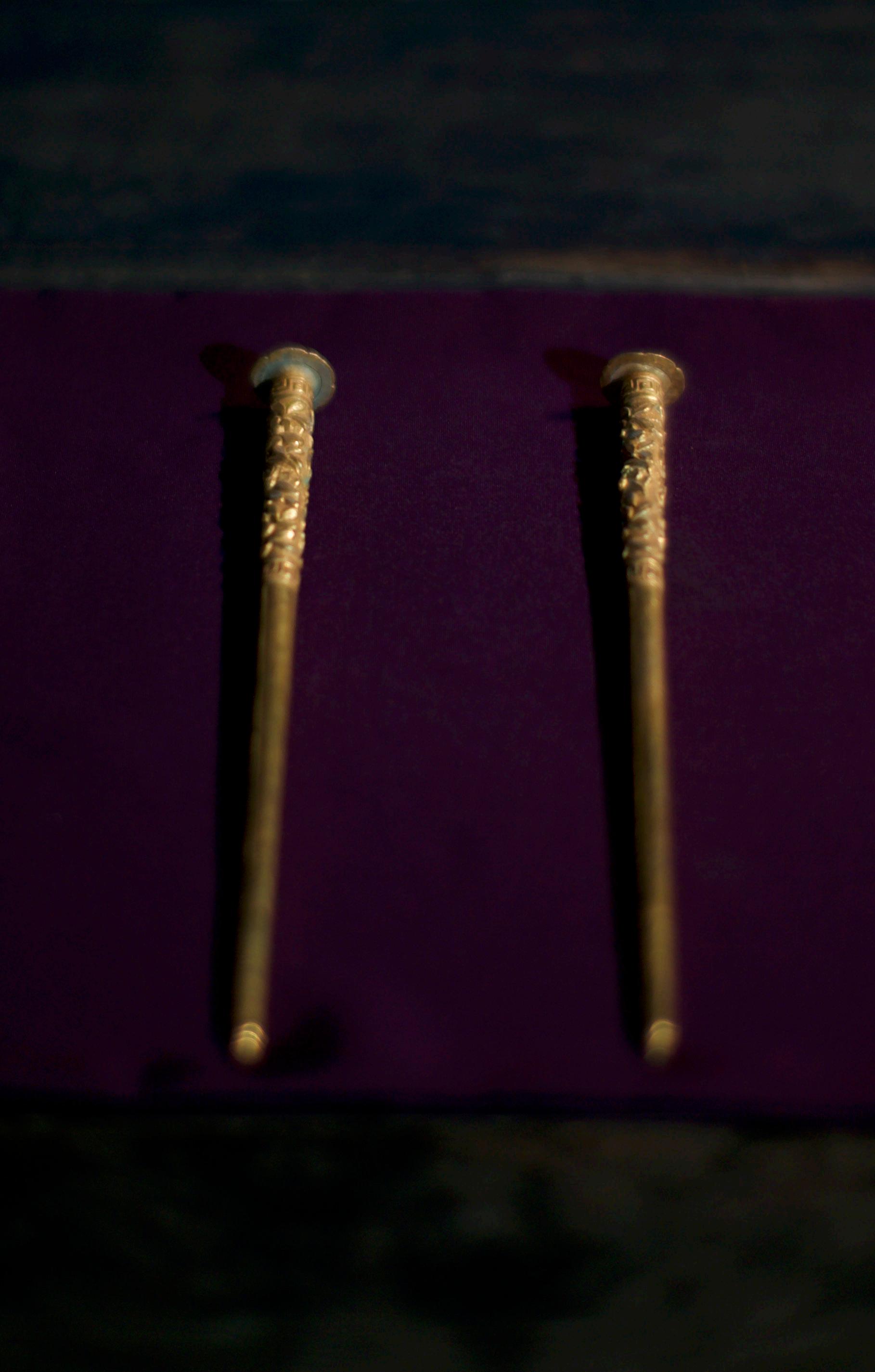
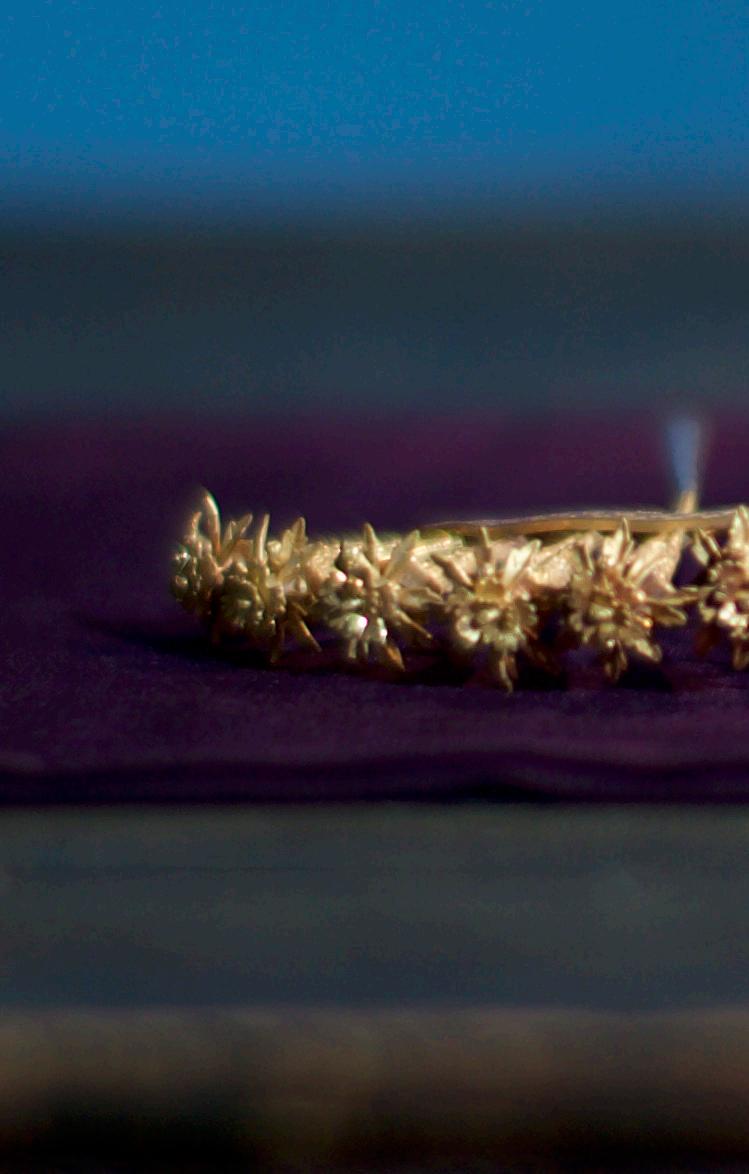
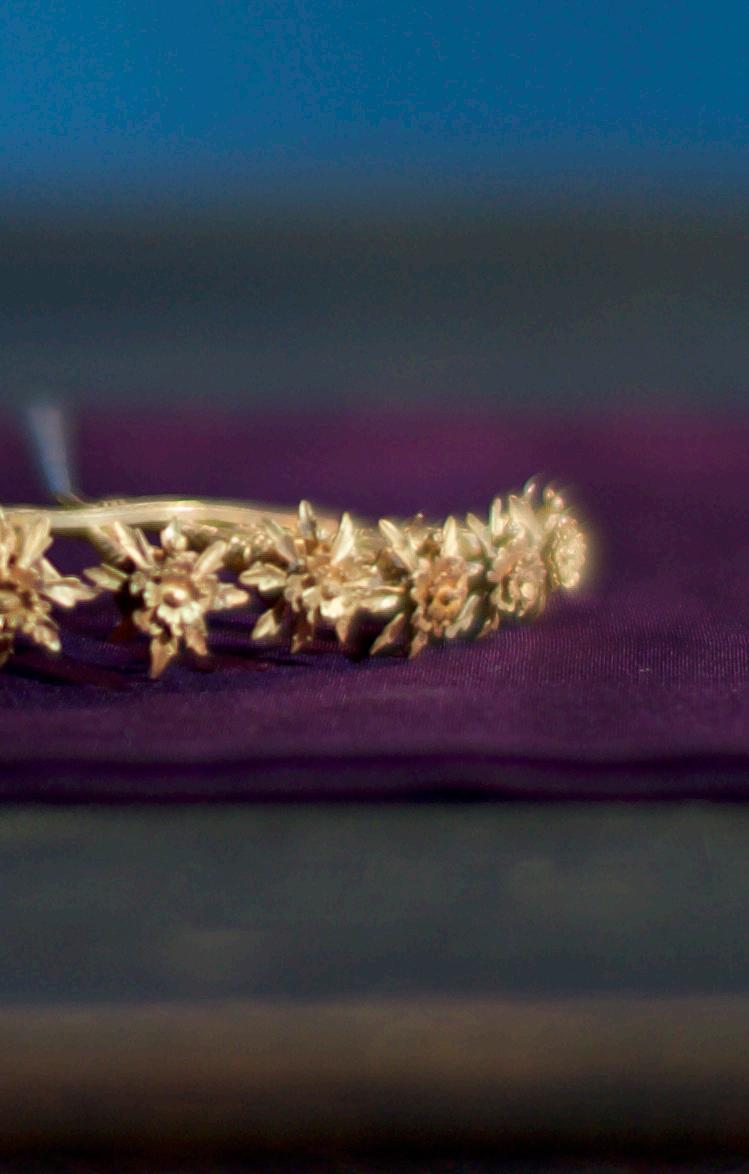
A Repousse and Chase Gold Diadem
SONG DYNASTY (AD 960 - 1279)
with twenty-two short upright columns joined as pairs and aligned in a rising arc, each slender tapered column decorated in high relief with leafy sprays of prunus and chrysanthemum on both sides and each pair capped with an oval chrysanthemum flowerhead motif, the decoration all in varied relief and with finely chased details throughout, the ‘U’-shaped terminals of each pair of columns soldered at the base to the extended terminals of the two outermost columns which are turned back toward the center of the arc and bent straight down to form twin tines, the whole applied on one side with a flat band of gold incised with double-line zigzag decoration incorporating triple-dot motifs on the front, soldered across the looped bases of the twin columns and turned onto the back at both ends to strengthen and complete the diadem.
橋形筒花金釵
寬 17 厘米
宋代(公元 960年- 1279年)
二十二根短而直的立柱成對排列,並呈上揚弧形連接,每根纖細漸尖 的立柱兩面皆以高浮雕雕飾梅花與菊花枝葉,雕飾層次豐富,細部錘 鏨精細。每對立柱頂端飾一枚橢圓形菊花花心,柱端成「U」形並在底 部焊接於弧形最外兩端的立柱延伸端,兩端向中心回折後再直向下 彎,形成雙齒狀結構。整體一側施以一條平扁金帶,金帶正面錘刻雙 線鋸齒紋與三點組成的裝飾,焊於雙立柱環形底端之上,並於兩端向 背面折回,以加固並構成完整的冕形結構。
寬 4 1⁄2 英吋(11.5 厘米)
考古發現顯示,此類金銀多花冕最早出現於宋代,至元代仍然流行。
據《湖南宋元窖藏金銀器發現與研究》(北京,2009 年,第 307 頁)所 述,金銀冕在南方出土較多,但山西、河南的宋、金時期壁畫中亦可見 其形象,顯示它們在中原地區同樣時尚。
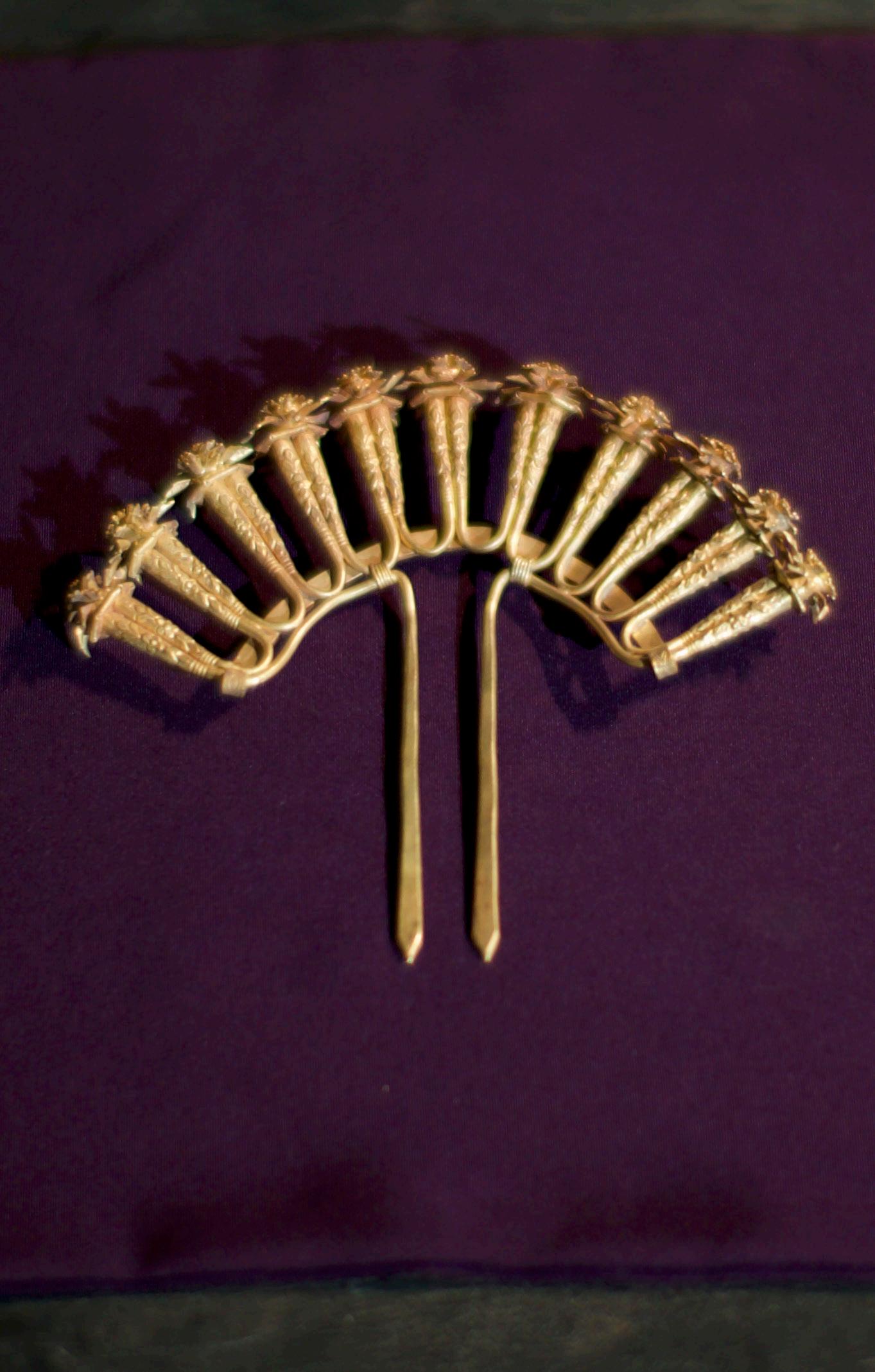
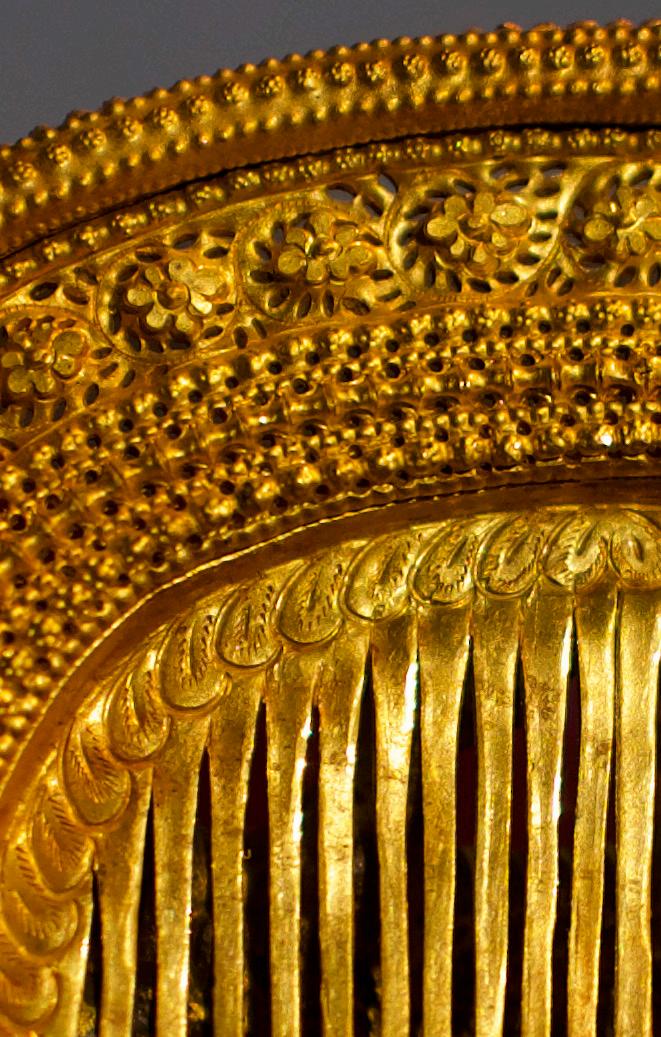
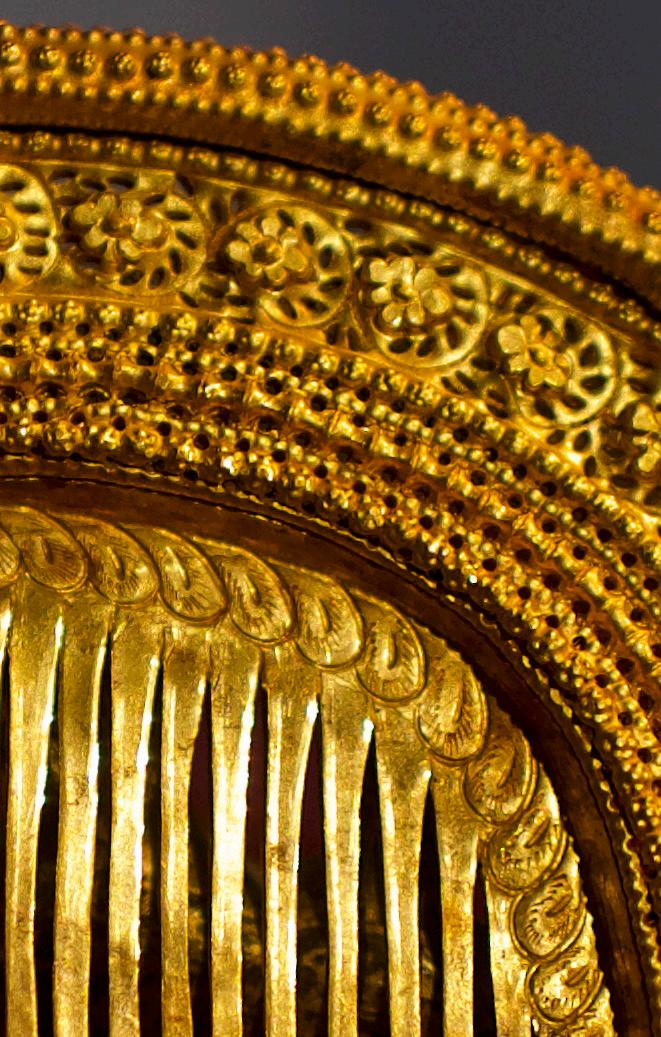
金梳
宋代(公元 960年- 1279年)
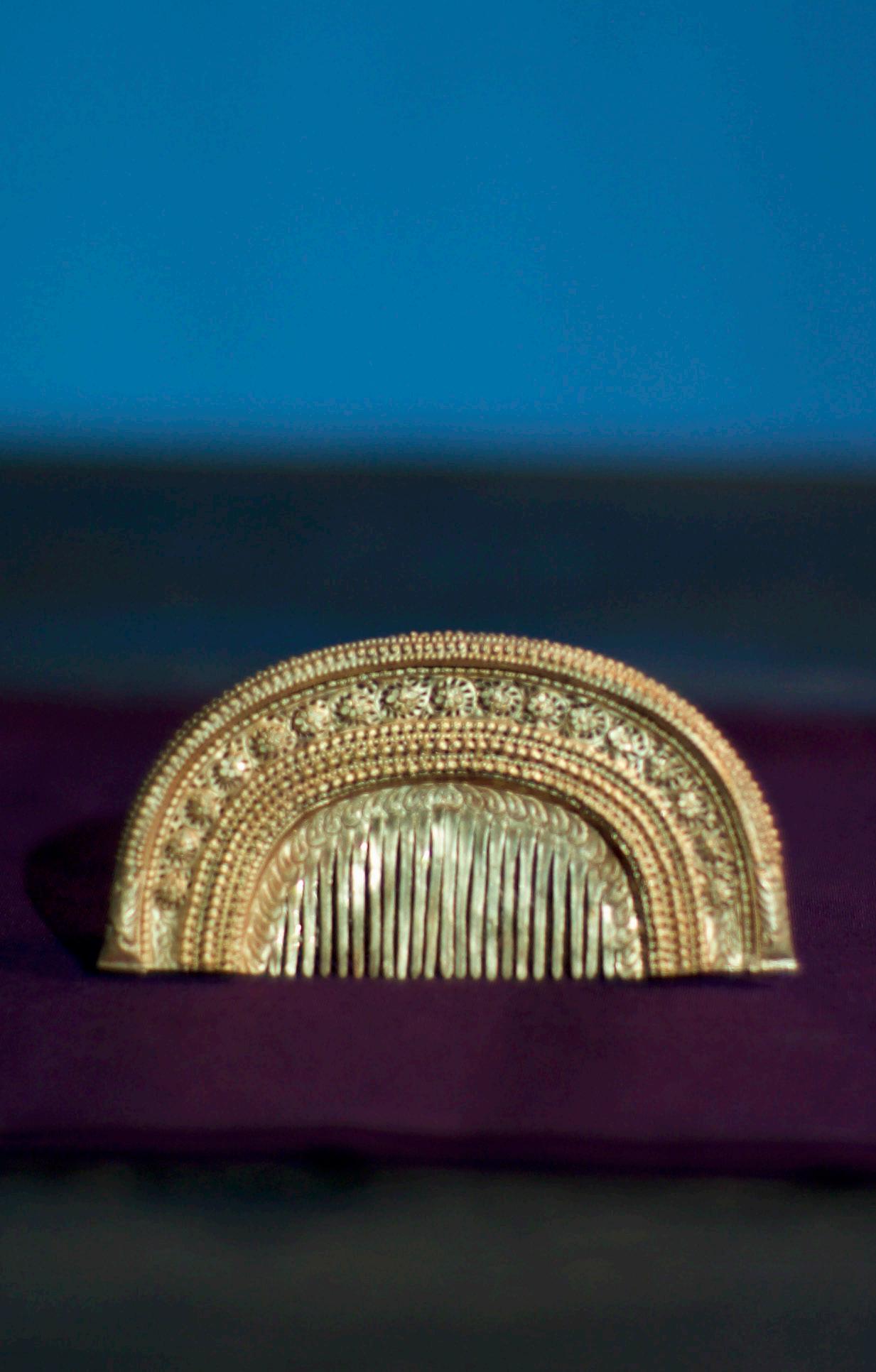
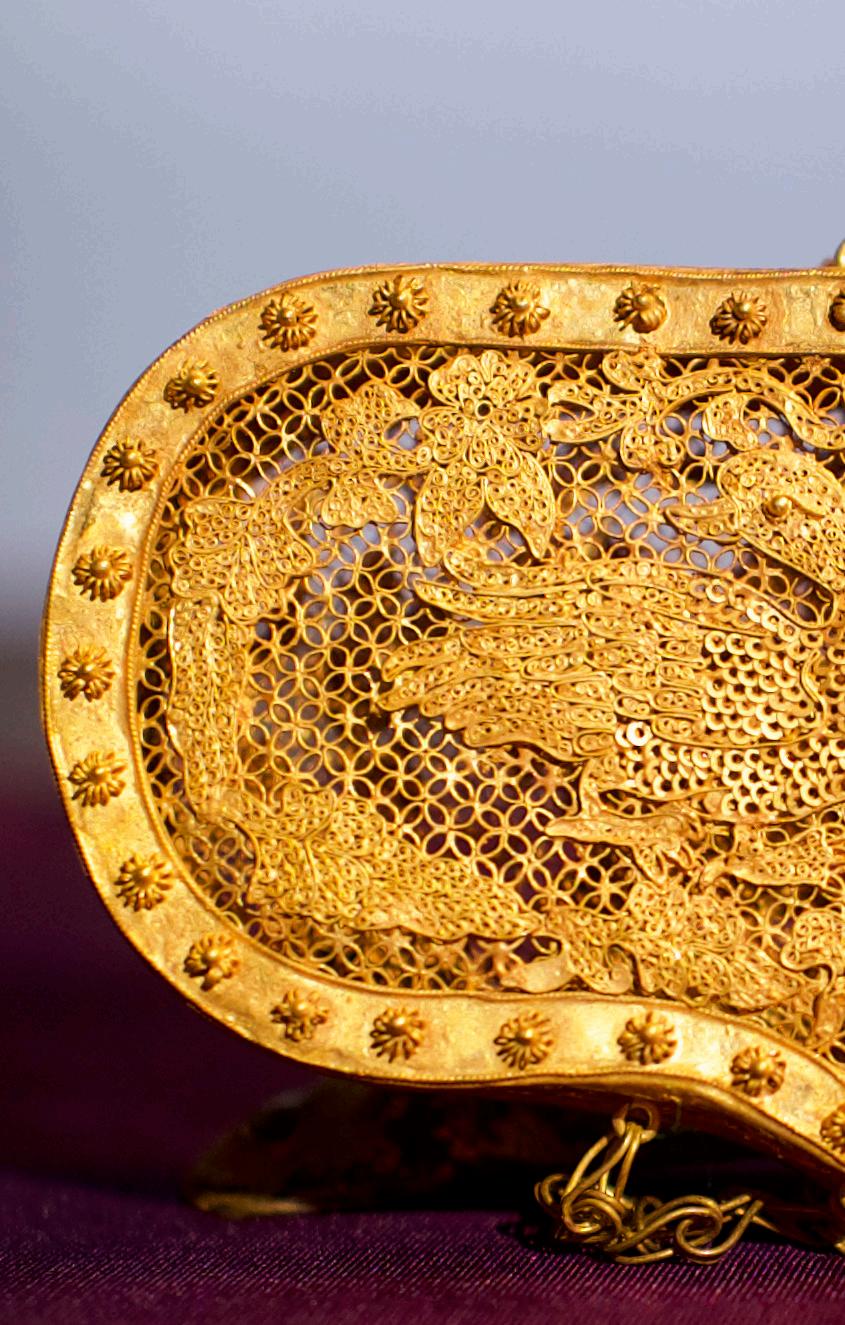
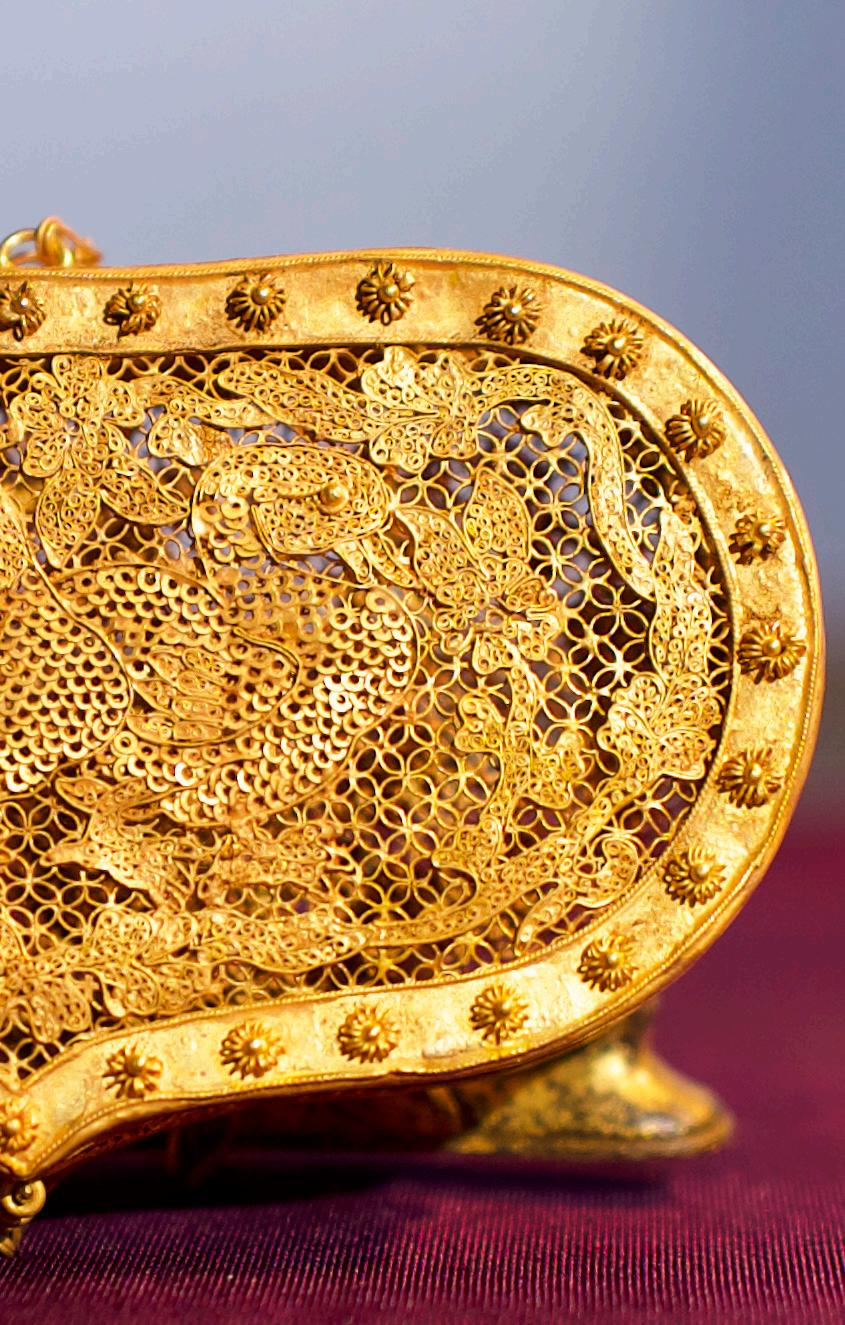
鴛鴦透雕金盒 明代(公元 1368年- 1644年)
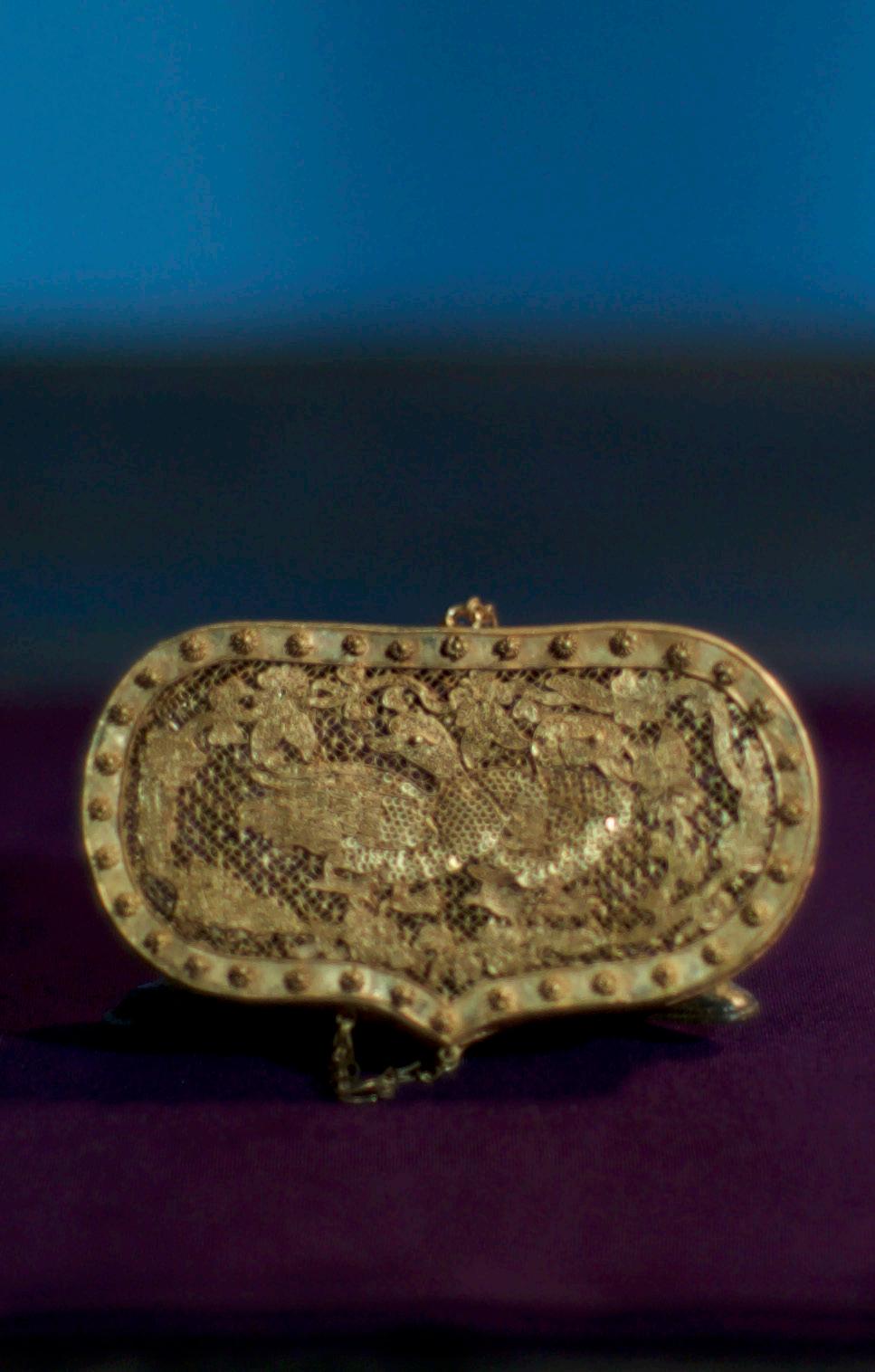

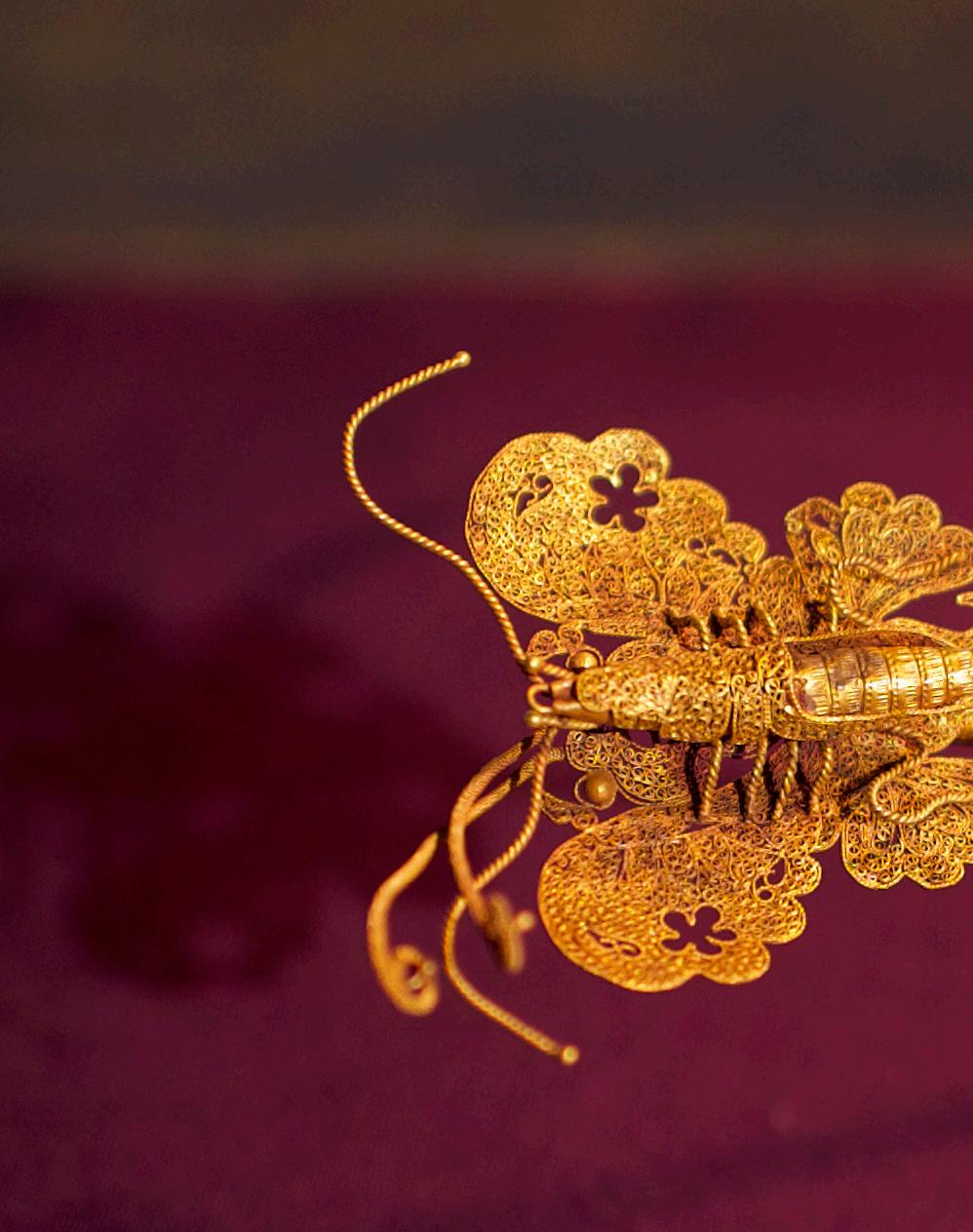
金蝴蝶髮釵
明代(公元 1368年- 1644年)
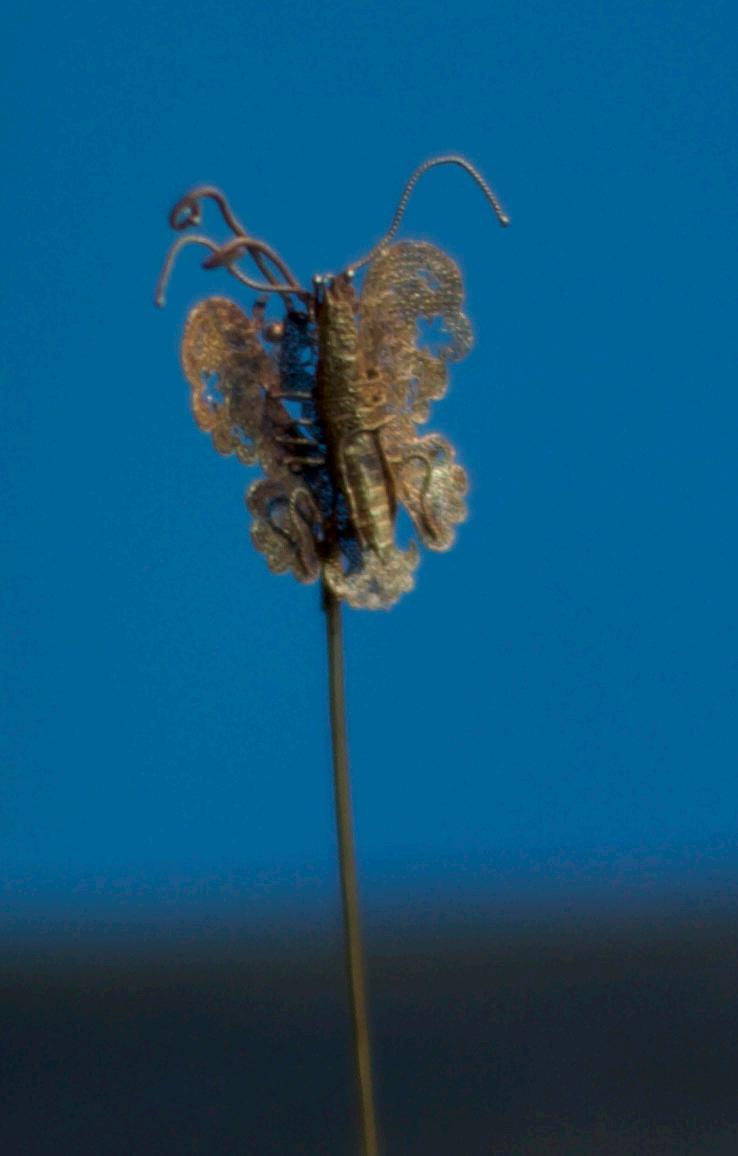
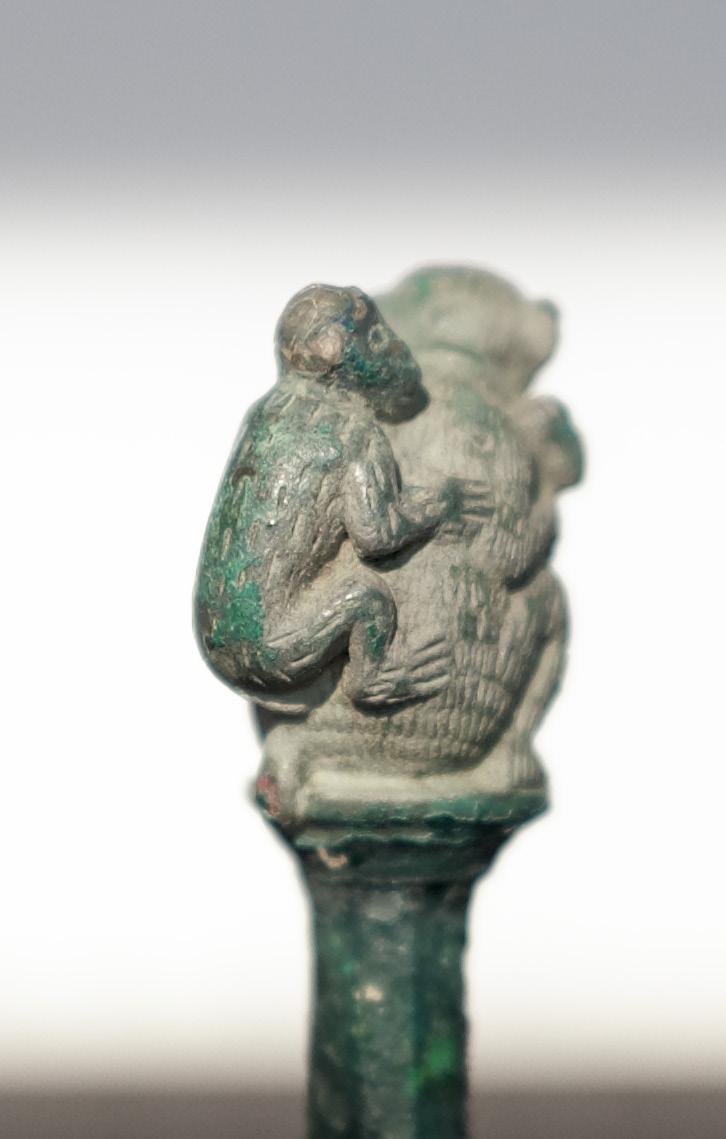
Email: midcolam.art@gmail.com
Instagram: Lamsgallery_Online WeChat: Midcolam1177
Website: http://www.lams-gallery.com